- Home
-
SHOP ECO FARM
- ECO Farm Grow Lights
- ECO Farm LED Grow Lights
- ECO Farm Quantum Board
- ECO Farm Samsung LED Grow Lights
- ECO Farm COB Grow Lights
- ECO Farm Commercial Lights
- ECO Farm Supplemental Grow Light
- ECO Farm Fluorescent grow lights
- ECO Farm HPS & MH Grow Lights
- ECO Farm CMH Grow Lights
- ECO Farm HID/CMH Bulbs & Ballasts
- ECO Farm Grow Tents & Kits
- ECO Farm 2x2ft Grow Kits
- ECO Farm 3x3ft Grow Kits
- ECO Farm 3.3x3.3ft Grow Kits
- ECO Farm 4x4ft Grow Kits
- ECO Farm 5x5ft Grow Kits
- ECO Farm Grow Tent - Standard Style
- ECO Farm Grow Tent - Extension & Roof & Lodge Style
- ECO Farm Extraction & Harvest
- ECO Farm Rosin Press Machine
- ECO Farm Dry & Wet Trimmers
- ECO Farm Oil Accessories
- ECO Farm Medicinal Plants Grinder
- ECO Farm Medicinal Plants Containers
- ECO Farm Medicinal Plants Dryer
- ECO Farm Refrigeration Dryer
- ECO Farm Climate Control & Other Accessories
- ECO Farm Inline Duct Fans
- ECO Farm Oscillating Fans
- ECO Farm Exhaust Fans
- ECO Farm Air Filter
- ECO Farm Duct Muffler
- ECO Farm Ventilation Kits
- ECO Farm Plant Humidifiers
- ECO Farm Plant Dehumidifiers
- ECO Farm Hydroponic Accessories
- ECO Farm Other Accessories
- ECO Farm Hydroponics Microscopes
-
TOP BRANDS
- Grow Lights Brands
- Adjust-A-Wing
- Apollo Horticulture
- Bestva
- Black Dog LED
- California Lightworks
- ChilLED Grow Light
- Eco Farm
- HLG - Horticulture Lighting Group
- Kingled
- Kind LED
- Mars Hydro
- Morsen
- Neilo
- NextLight
- Phlizon
- PlatinumLed
- Roleadro
- Optic LED Grow Lights
- ViparSpectra
- Vivosun
- EYE Hortilux
- IPOWER
- NanoLux
- Phantom grow light
- Gavita grow lights
- Grower's Choice
- Lumatek
- Maxibright
- Yearld Pro
- ThinkGrow
- Crecer Lighting
- Green Sunshine Electric Sky
- fohse aries
- loriflux
- luxx
- fluence
- iluminar
- Lex
- LTC
- Rayonled
- FGI
- PHOTONTEK
- Grow Tents & Kits Brands
- Apollo Horticulture
- Black Box
- CoolGrows
- Eco Farm
- GrowLab
- Gorilla Grow Tents
- Mars Hydro
- Quictent
- Secret Jardin
- Unit Farm
- TopoGrow
- VIVOSUN
- Topolite
-
COMPANY INFO
-
COOPERATE WITH US
- Blog
3 Best 600W Professional LED Grow Lights: Your Buyer's Guide of 2022
October 14, 2022
When you decide to buy LED grow lights, you not only want to invest in indoor plants, but also make sure they are the best LED grow lights. Grow lights have proven to be very important over the years, and since LED lights became popular as a technology, many indoor growers have turned to them!
Over the course of this article, we’ll first cover the uses of grow lights, then we’ll look at what you need to consider before buying LED grow lights, and then the best LED grow lights.
Are LED grow lights best for indoor plants?
Yes! All of these provide the spectrum needed to complete a plant indoors.
(You can also place them in mushroom grow tents — but when you grow mushrooms, you can usually use cheaper light sources than these.)
It’s part of the hustle and bustle about LED lights today.
According to a NASA study, LEDs provide the optimal wavelengths of light that plants need to grow.
Additionally, depending on the stage your plants are in, the schedule and configuration of the colored LEDs can be easily controlled to promote plant growth or flowering growth.
Maybe you’ve heard someone say LED lights are bad in the past. But the industry is growing rapidly.
In other words: now is a good time to switch your grows to LEDs (if you haven’t already).
ECO Farm ECOD Samsung UV+ IR 640W Dimmable LED Grow Light
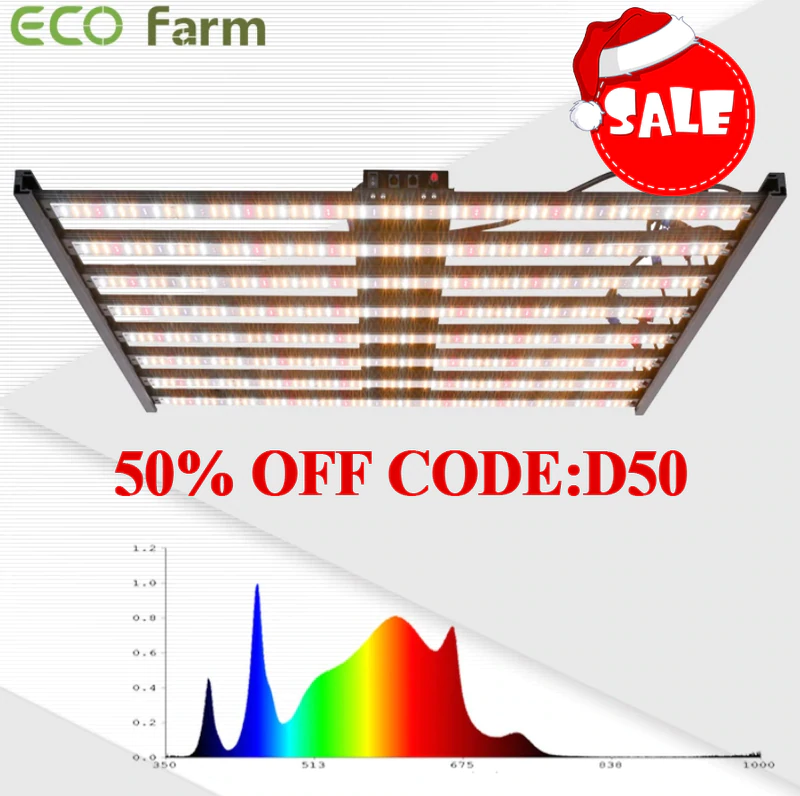
Features:
This ECO Farm full-spectrum LED Grow Light uses 1314 pcs upgrade SMD lamp beads (3000K, 6500K and 660nm). Adequate and sun-like light can prevent the growth of plants from spindly and moulding. The best lighting solution for indoor hydroponics and soil cultivation, such as potatoes, peppers, tomatoes, etc, is most suitable for the various growth stages of plants. The high-reflective optical principle guarantees emitting uniform light, 98% of light can be absorbed, and plants love it. LED light spread at a close distance from the crop canopy and delivers outstanding results for indoor grow, greenhouse and grow tents. Increase 15% — 30% yield, help plants grow healthier. The 6 bar led grow lights, are suitable for all plant growth stages, seedlings and any other fruits and vegetables. The LED grow lights use a high-quality aluminium heat-sink design, it makes excellent heat dissipation.
Spectrum King Phoenix 680W LED Grow Light
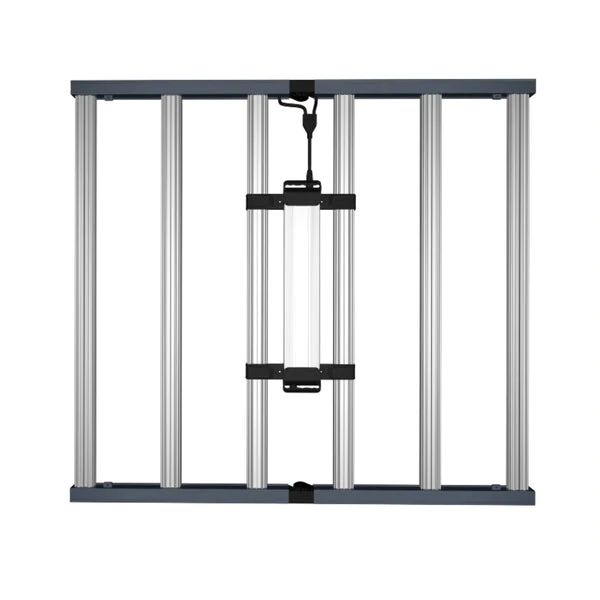
Features:
The Spectrum King LED grow light is the new LED standard for a 1:1 1000W DE HPS replacement that consumes 36% less power while offering the highest reliability in the industry. SK Cryo-Therm cooling technology enables an ultra-thin profile that maximizes airflow and minimizes microclimates. This grow light is optimized for single or multi-level planting close to the canopy. Many growers are switching from heat-generating HPS lights to ultra-high performance LED strip lights. SonoFarm LED grow lights utilize the latest technologies on the market — from intensive research for optimum performance, to customising the spectrum for the highest possible yield.
Fluence SPYDRx Plus 685W LED Grow Light
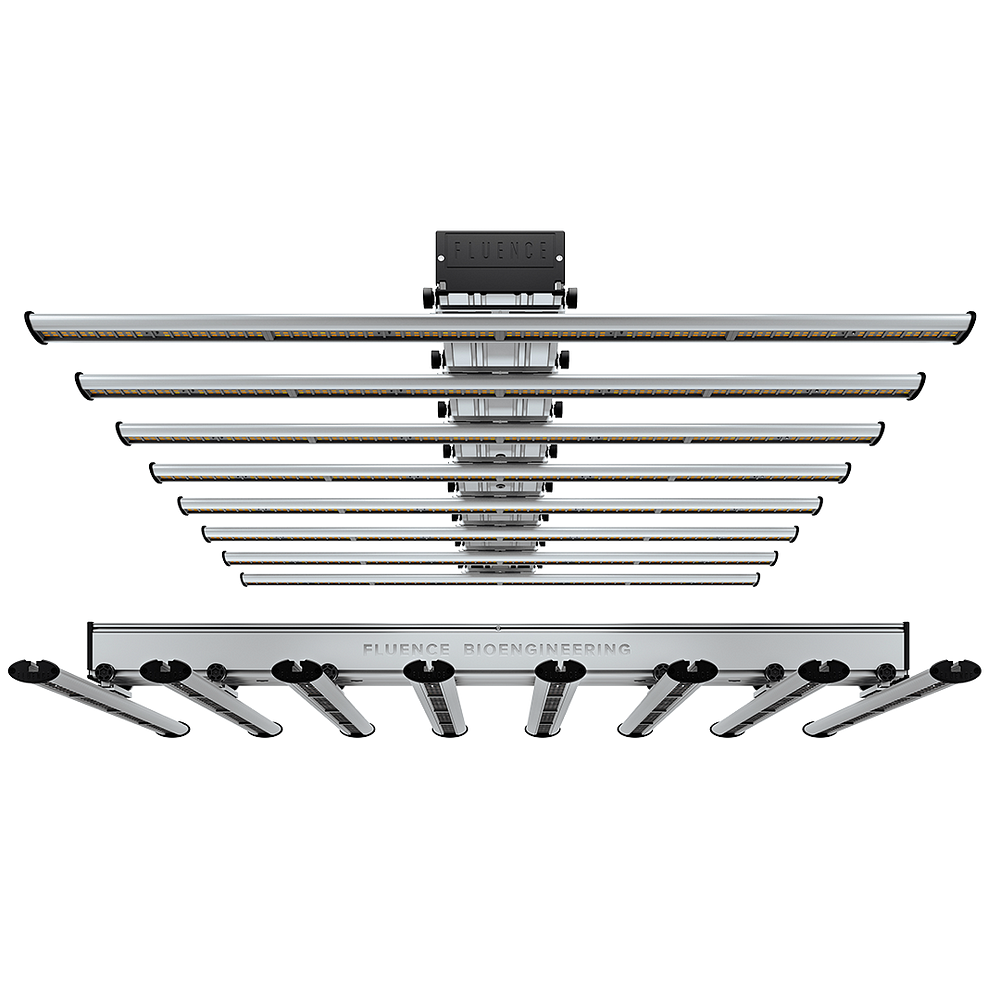
Features:
SPYDRx PLUS is a full-cycle top lighting solution for commercial horticultural planting with the ability to grow from vegetative to flowering. The SPYDR series is only 4.6" thick, with a recommended installation height of only 6" from the top of the canopy, and is designed for vertical farming — from vegetables to flowering — with an average PPFD of up to 1,030 µmol/m2/s on a 4'x4' top on the canopy. All SPYDR models can be dimmed with an optional light intensity Dimmer for precise control of the PPFD and provide flexibility to instantly adapt to new crops with varying light requirements. Recommended installation height is 6" for optimal light uniformity, penetration and flux density above a 4'x4' canopy.
How To Choose The Best LED Grow Lights For A Grow Tent
Since LED grow lights can be expensive, you shouldn’t buy them willy-nilly. There are things to consider if you want to make a smart purchase, such as:
Lifespan
One of the biggest benefits of LED light products over others is their burning time. Some brands have managed to produce LED grow light with a lifespan of 100,000 hours or so, which is admirable, to say the least.
However, don’t expect all LED lights to have such a long lifespan. Around 50,000 or less is what you should expect, and anything over it is a huge plus.
Still, it’s a lot more compared to others and you do get the best value for your money.
Generally speaking, the best grow LED lights are long-lasting, but make sure to check the lifespan of the light you choose for your tent so you know what to expect.
Shape and size
You have to match the size of the light to the size of your grow tent to ensure the heat balance and that your plants receive the heat evenly during each growth stage.
While the shape is not crucial, you can choose between different types according to your preferences.
The great thing about LED grow light is that they come in different shapes and sizes, so be sure you’re getting the ones that suit your grow tent and your plants the best.
Efficiency
Every LED grow light features info about energy efficiency. Usually, you’ll see it expressed in μmol/J or micromole per Joule.
This measurement determines how efficiently a light converts electrons into photons. The higher the value, the more efficient the light.
LED lights are generally highly efficient.
We don’t have to tell you the significance of energy-saving capabilities — if you have a grow tent (or tents), you know that inefficient lights can run up your electric bill in the blink of an eye.
Installation
Most of the best LED grow lights for grow tent are not complicated to install.
The ones that made our list are all fairly easy to install and use, so you ought to be able to do it yourself without any issues.
If, however, it comes to that, they come with detailed instructions that can help you out.
Worst case scenario — you can call a professional to help you install the light properly.
Price
When choosing the best LED grow light, we can’t dismiss the price points, especially since some models cost twice as much as others.
That being said, we’ve made sure to include excellent choices from both sides of the price spectrum, so you can choose between high-end items and budget-friendly options.
On average, an LED grow light goes for $200. You can find options under this amount, and there are plenty that cost a lot more.
The bottom line is — think about your budget and how much you can (and want) to cough up for LED grow light, and start from there.
Sure, the expensive ones may have better features, but don’t dismiss the cheaper ones so easily, they might surprise you!
Dimming abilities
Most products and brands mentioned today have amazing dimming options.
It’s vital to consider the dimming capabilities of the best LED light for grow tent. In other words, you have to think about the light intensity.
Different growth stage requires different light intensity, so proper dimming options are crucial.
Power consumption
Most LED grow lights consume around 300W in a grow tent. Some use less energy, some use more, so don’t forget to check the exact power consumption before purchasing.
Heat sinks
A LED grow light for a grow tent should feature a sturdy, ergonomic design with aluminum heat sinks that dissipate heat in grow tents.
This is important for any growth stage so your grow tent doesn’t get too hot and burn your plants.
Full-spectrum lighting
Full-spectrum lighting is a vital part of LED grow light products.
Growers know the importance of adequate light in every stage of plant growth, and the only way you can achieve that in grow tents is with a full light spectrum.
Conclusion
With so many different brands of LED lights on the market, choosing just one can become tedious. You need to consider not only the quality of the product, but also the price point. Here, we’ve compiled the best options that we hope will meet the needs of different users and help them find the best option for every grow room enthusiast on the market.
Best 480W LED Grow Light For A 4x4 Grow Tent - 2022
October 13, 2022
Using LED grow lights in a 4×4 grow tent will produce high quality shoot development while using less energy and producing less heat. But quality matters. LED grow lights are an expensive investment. Product descriptions can be confusing. and is misleading.
When choosing the best LED setup for your 4×4 grow tent, pay attention to power and diode quality. Try to buy the best LED lights you can afford. Don’t be fooled by cheap copycats who boldly promise a “1000-watt HPS replacement” for under $200. 4×4 LED yield depends on the quality and intensity of the light, which is only available with higher-priced LEDs.
How many watts does it take to grow plants in a 4×4 foot grow tent?
Based on the best LED grow lights currently available that effectively cover a 4×4 grow space, the answer is 450 watts minimum.
The long answer is that you shouldn’t pay too much attention to wattage, as some grow lights use 450 watts or more and won’t properly cover 4×4 feet. So I would say wattage, coverage area and light intensity are the main factors to consider together.
How many plants can fit in a 4×4 foot tent?
It depends on how big of a plant you plan to grow. For example, you can train a plant to grow very wide and take up half of the tent. In this case, the answer is two. Otherwise, I recommend giving each plant 2×2 feet of space, so you can fit a total of four plants in a 4×4 grow tent.
ECO Farm ECOD Samsung UV+ IR 480W Dimmable LED Grow Light
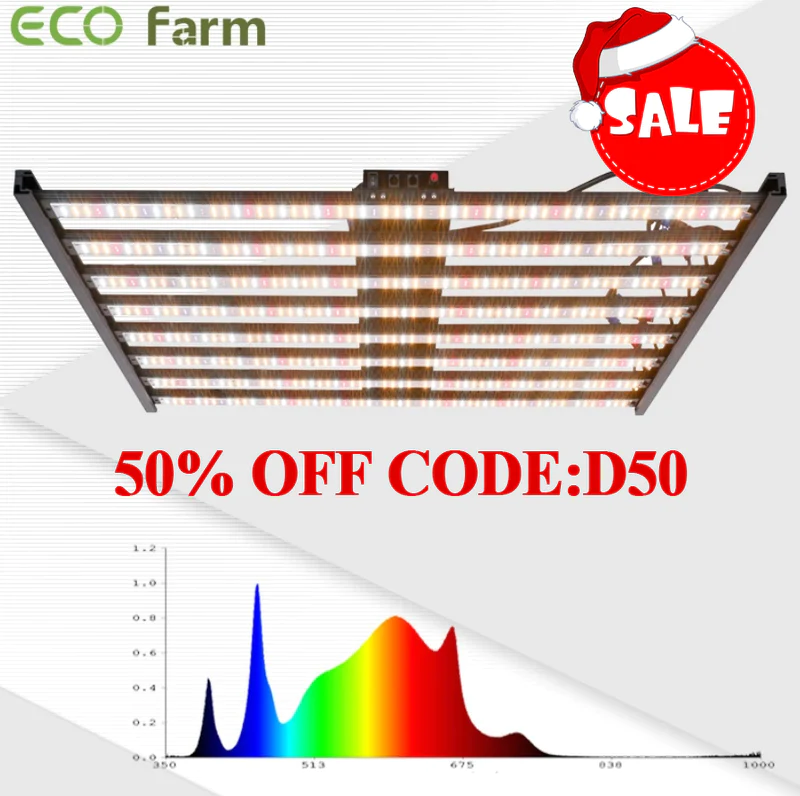
Features:
The ECO Farm full spectrum LED grow light was designed to help enhance photosynthesis so you can enjoy stronger and healthier crops! This linear horticulture lighting fixture produces a broad-spectrum lighting output made for Vertical Farming and indoor use. This premium LED growth light is an energy-efficient system that helps you to make important savings. This full spectrum LED grow lights come with 876pcs leds. Excellent spectrum mimics the sun spectrum, optimizing the whole stages of indoor growing plants from seed to flowering, to maximize the yields and ensure crop quality. It has a 2.8 umol/J efficiency level so you can make sure that this grow light system is a sustainable and eco-friendly solution for your garden. The aluminum housing material is durable and reliable. This top growing light for plants uses broad spectrum LEDs that can enhance nutrient absorption. It has an IP65 waterproof design that is perfect for indoor use or greenhouses. At 480W, 1009.8 µmols light output is higher than HPS lights, while using less energy.
Spider Farmer SE5000 480W Full Spectrum LED Grow Light
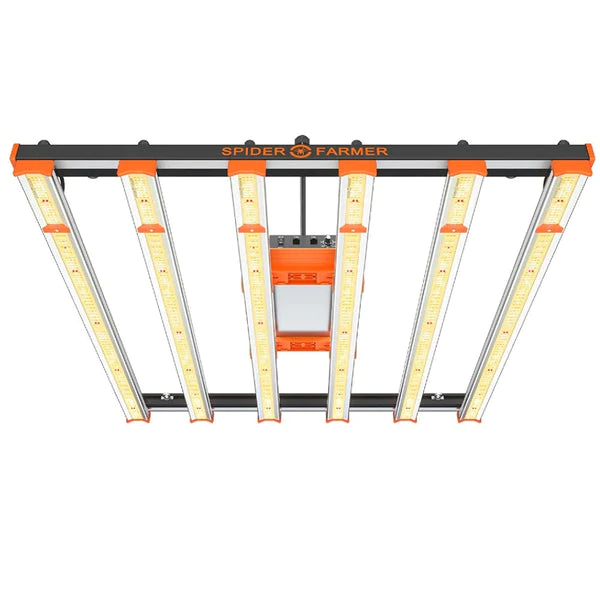
Features:
This Spider Farmer LED grow light features a uniquely designed 6 extended LED strips that provide more even canopy coverage, especially on the outer edges of the growing area. With 1680 SAMSUNG LM301B diodes, the SE5000 Led Grow Light consumes 480 watts at 1333 umol/s, achieving an impressive PPE of 2.75 umol/J, covering a high yield full-cycle growth of 4'x4'. The full spectrum (380–410nm, 660–665nm, 730nm, 3200–4200K, 4800–5000K) is ideal for vegetable flowering to suit every stage of the plant cycle. The dimmer knob is ideal for growers to adjust the light intensity for different growth stages. The daisy chain feature allows you to connect up to 30 spider farm grow lights — dimming multiple lights at the same time.
TotalGrow MH Lumyre 480W LED Grow Light
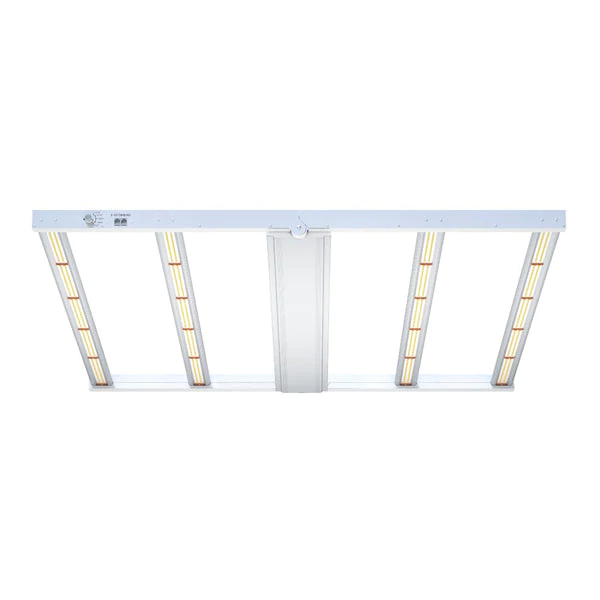
Features:
TotalGrow LED grow lights feature multiple high-intensity light strips in a slim profile and built-in power supply to distribute the ideal light intensity evenly across your growing area to meet your growing goals. Superior, customizable full spectrum supports efficient, high-quality growth of any life stage and crop variety. This plug-and-play solution with direct daisy chaining is easy to implement, has low up-front and ongoing costs, and sustainably produces high-quality crops. The efficacy of this LED grow light is as high as 2.8 μmol/J to meet the light intensity your plants need. Robust, reliable, ideally shaped design for ease of use and excellent uniformity.
Buying Guide
When it comes to choosing the best LED grow light for a 4×4 grow tent, there are a few things you need to consider.
First, you need to decide what size of light you need. A 4×4 grow tent is a good size for a small to medium sized grow. So you’ll want a light that is small to medium in size.
Second, you need to consider the wattage of the light. A good LED grow light for a 4×4 grow tent should have a wattage of at least 300 watts.
Third, you need to consider the price. A good LED grow light for a 4×4 grow tent should be affordable.
Finally, you need to consider the brand. A good brand will have a good reputation for making quality LED grow lights.
Conclusion
As you can see, there are many factors to consider when choosing grow lights for a 4X4 tent. However, if you keep the factors we’ve discussed in mind, you should be able to easily find the product that best suits your needs. Just check out our recommended list above to get started.
Don’t forget to do your research and ask for help when you need it. If you do, you’re sure to find the best 4X4 tent grow lights you love and will last for years. Good luck.
The Best LED Hydroponic Grow Lights to Grow Your Indoor Plants in 2022
October 12, 2022
Plants cannot grow without photosynthesis, and plants cannot photosynthesize without light. Grow lights mimic natural sunlight to stimulate photosynthesis in indoor plants. The best grow lights are suitable for both the plants you want to grow and the indoor space where you want to grow them. To learn more about houseplants, read our guide to the best houseplants to grow indoors.
What are the Purpose of Buying a Plant Grow Light?
A grow light or plant light is an artificial light source to stimulate plant growth by emitting a light appropriate for photosynthesis. This light spectrum is similar to that of the sun. Grow lights are used for horticulture, indoor gardening, plant propagation from cuttings, seed germinations, Indoor food production — specially for those zones which do not receive adequate sunlight, indoor hydroponic gardening and to grow aquatic plants.
ECO Farm DBL3000 Full Spectrum LED Grow Light 320W
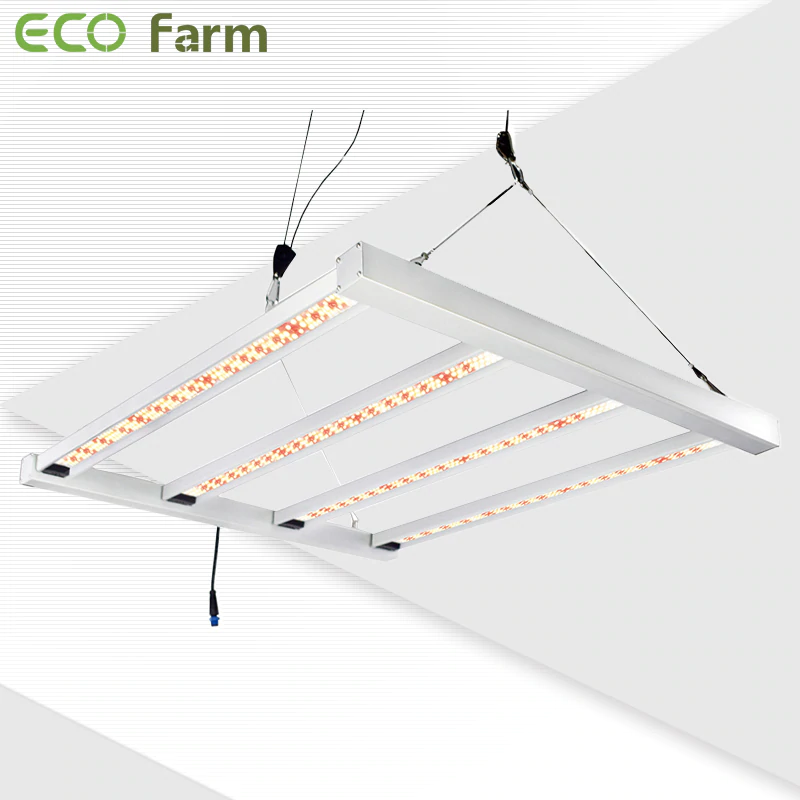
Features:
This ECO Farm led grow light is equipped with SAMSUNG LM281B diodes.It draws 320 watts achieving an impressive PPE of 2.5 umol/J, coverage for 3'x3′ of high-yielding full-cycle growth. Simple structure, no fan, no noise. Four aluminum light bars for better heat disappear and stay cool while enabling even light spread. Save you a lot at ventilation and exhaust. Proven high-yield full spectrum(3000K, 5000k, 660nmnm, 30nm) with enhanced deep red 660nm. Born for big buds, Rapid plant response from seed to flower speeds up flowering time and boosts yields. Easy dimming design meets the needs of indoor plants at different stages of growth. The most powerful daisy chain-max up to 15 DBL3000 growing light can be connected, controller available, especially beneficial for home, grow tent, grow room, greenhouse, garden.
Spider Farmer SE3000 300W Dimmable Full Spectrum LED Grow Light
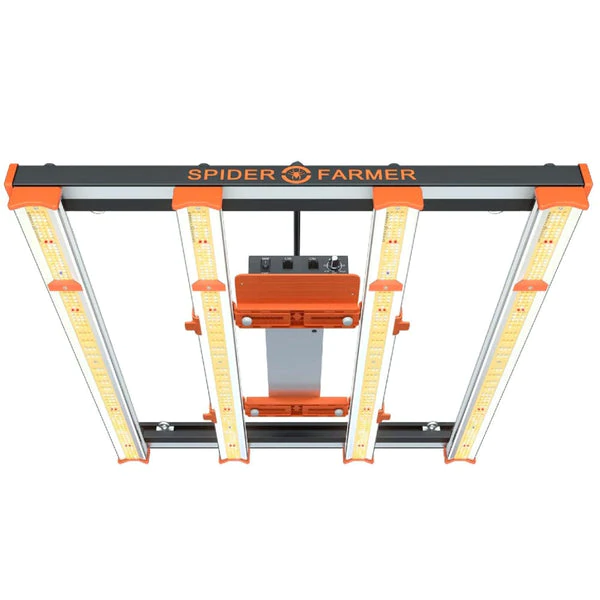
Features:
This Spider Farmer LED grow light features uniquely designed 4 LED strips that extend to the edge to provide more even canopy coverage, especially on the outer edges of the growing area. With 896 SAMSUNG LM301B diodes, the SE3000 Led Grow Light consumes 300 watts at 822.82 umol/s, achieving an impressive 2.75 umol/J of PPE, covering a high yield full-cycle growth of 3'x3'. The full spectrum (380–410nm, 660–665nm, 730nm, 3200–4200K, 4800–5000K) is ideal for vegetable flowering to suit every stage of the plant cycle. The dimmer knob is ideal for growers to adjust the light intensity for different growth stages. The SE3000 grow light comes with a detachable driver and long power cord to reduce ambient heat in the grow space for a longer lifespan.
Fluence SPYDRx 340W LED Grow Light
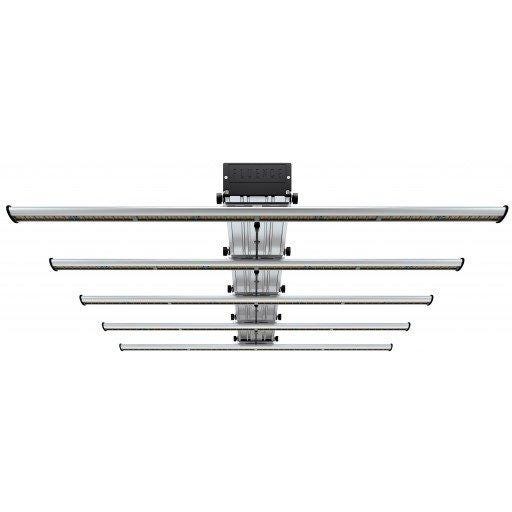
Features:
SPYDRx 340W LED 455 avg PPFD, high efficiency, low profile, for 730 umol/s, 2.15 umol/J at 340W as a vegetative stage, top-lighting solution for commercial or as a full-cycle top-lighting solution for residential applications without CO2 supplementation. Full Spectrum PhysioSpec Indoor for optimal photosynthetic targeting. Fluence SPYDRx a 340W LED indoor grow light with an average — , not max — PPFD above 455 is perfect as a vegetative stage. Anodized, extruded aluminium alloy chassis with integrated heatsink for longevity and passive, natural convection thermal management (no fans or moving components). Recommended mounting height 6 inches from the top of the canopy for best canopy penetration, optimal light uniformity, and flux density above a 4ftx4ft canopy.
What To Look For When Selecting a LED Grow Light
When selecting a LED grow light there are a number of factors you need to consider for yourself, which include:
Materials
Durability is key when selecting your new lighting rig. A good quality lamp will be around for at least a decade.
And with products that last longer, you can invest more into them. Electrical Output and Consumption
Your LED hydroponic grow light will need to be on for around 10–11 hours a day. Depending on your hydroponic unit, you’ll want to ensure that your unit is drawing the least amount of power.
Low Heat
LED lights that get too hot will damage themselves and the plants. You need to be sure that the unit is pumping out the least amount of heat.
And if it does overheat, the heating management system should do its job well.
Space and Plants
A major factor will also be the space you’re growing your plants in.
Spaces with little to no ventilation will cause mold to form on the plants.
And if you share a space with the LED lights, you’ll want to consider noise issues.
Ease of Use and Daisy Chain
Your LED hydroponic grow lights need to be simple to operate. Otherwise you won’t utilize all the great features.
Ease of use also extends to installation. An easy to install unit is one that gets to work faster.
For ambitious growers, you will want the option to expand your grow project. Make sure you’re happy with the amount of units you can link up to one another.
Warranty
None of these options are especially cheap. Thus each unit should come with a warranty or return policy.
Don’t purchase a unit if there’s no warranty or return policy.
Conclusion
If you think finding the best LED grow lights is complicated, I won’t lie — it will be at first. In the long run, adding great value to your grow equipment will set you up on your journey to becoming a professional grower.
So try to consider these LED grow light options I have listed and make the challenging part of being a grower easier!
ECO Farm Z6–600 Samsung LM301B LED Grow Light VS Sunking Model X 660w LED Grow Light
September 30, 2022
Limited outdoor space and inclement weather don’t necessarily keep you from enjoying a variety of lush plants. Grow lights allow you to bring your garden indoors, providing the nourishing energy of the sun in a controlled area. Even professional gardeners rely on grow lights when they need to keep plants safe from pests, frost, and other external hazards.
Replacing the influence of the sun is no easy task. When you have a few plants, high-quality lighting is required to get satisfactory results. Start outfitting your ideal indoor space with our review of the eight best grow lights for indoor plants.
Advantages of LED lights
For all the downsides an LED grow light can bring, there’s no denying that it has all sorts of benefits. From sustainability to healthier plants, here are some of the top reasons growers choose LED bulbs in their grow rooms:
Faster Harvest Cycle
LED lights can be used up to 24 hours a day, ultimately allowing you to shorten the seasons and increase the growth rate of your plants. These lights help growers achieve multiple harvests each season, resulting in higher yields over an extended period of time.
Longer Service Life
LED grow lights have a lifespan of up to 50,000 hours, thanks to their relatively low operating temperature compared to other light sources. While their up-front cost can be high, it may be worth it for the longer lifespan you’ll enjoy, saving you from having to repurchase and reinstall lights as often as you would with other lighting options.
Energy Saving
In general, LED lights consume approximately 60% less energy than other traditional lighting options, while still providing the same level of light. They generally emit less heat and provide more usable light than other systems used to grow plants. If recurring energy costs are a concern, the long-term benefits of LEDs may more than make up for their higher initial price tags.
Full Spectrum Light
High-quality LED lights will provide a full spectrum of light, which means they’ll give your plants all the light they need to thrive — no more, no less. Most LED lights also allow you to adjust the wavelength according to the stage of the growth cycle your plants are in, resulting in better growth than in outdoor sunlight.
For many seasoned commercial growers, choosing the perfect light for each variety is the difference between a very good flower and dazzling judges and demanding customer loyalty.
Healthier Plants
While LED lights do emit UV light, they don’t emit nearly the same amount of UV light as other light sources, and too much UV can cause trouble for nearly all living things in the sun. Plants grown with LED lights tend to be healthier due to less UV exposure and have less risk of leaf burn, nutrient loss or nutrient lock-in due to damaged fan leaves (which may require pruning to reduce damage to other parts of the plant) .
ECO Farm Z6–600 Samsung LM301B LED Grow Light
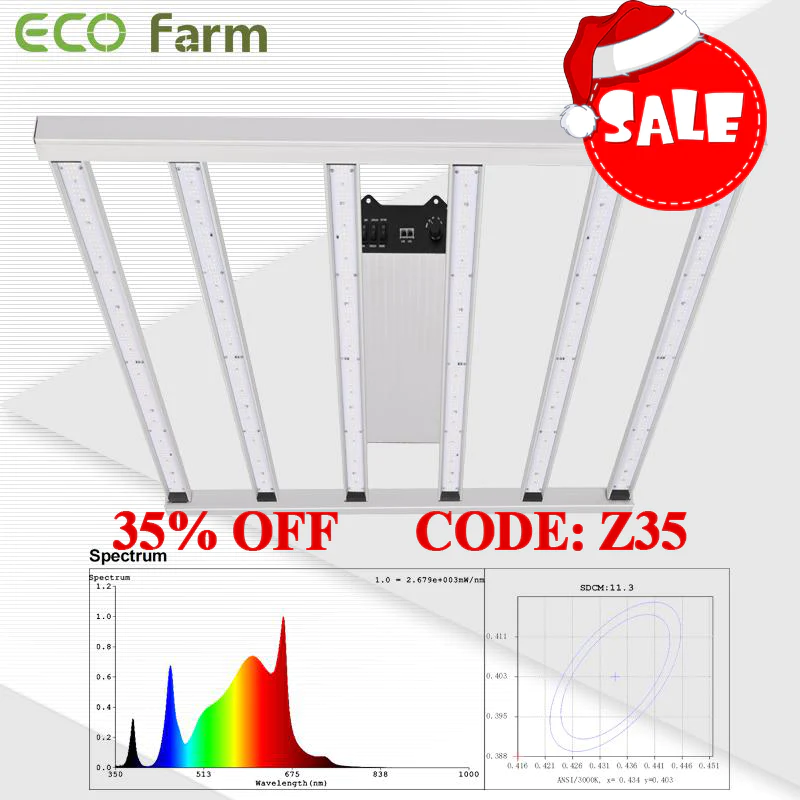
Features:
This ECO Farm LED grow light has 1632 individual LED’s covering the Samsung LM301B Full Spectrum White Light Diodes, 660nm Red Diodes, IR+UV Diodes on independent controls. our grow lights are ideal for all growth stages. Plus, it works and supports all growth stages such as full bloom and high yield growth. ECO Farm’s high-quality product is a USA brand and constructed to last for years. We use the highest quality materials and back our products with a 5-year warranty. Our top-of-the-line components allow us to stand behind our product for years longer than our competition, making it the best choice for LED Grow Lights. Many growers are switching from the heat-producing HPS lights to our ultra-high performance LED bar lights.
Sunking Model X 660w LED Grow Light
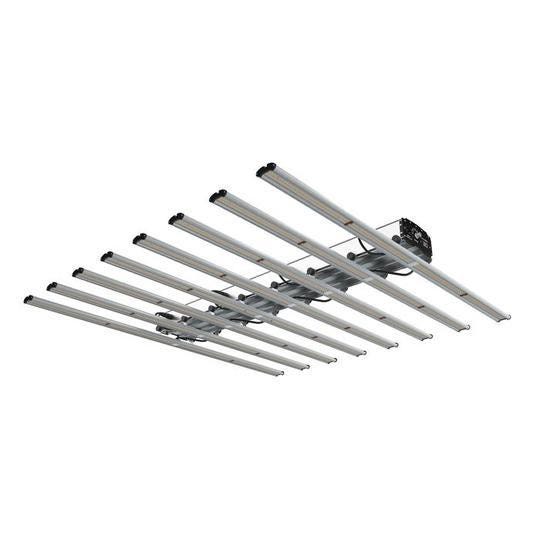
Features:
Capable of supporting photosynthesis, the LED grow lights are for places where there is little to no sunlight. It’s perfect for home use, greenhouse use, and laboratory use, the bulb is sure to provide flowering results. Ideal for indoor gardens, hydroponics, and aquatic plants, these grow lights are essential in promoting perfect plant growth and maturity. Maximize your yields & profits with this LED Grow Light. Switch from HPS to it and increase your yields & profits 30–70+% without adding any additional heat, energy costs or cooling requirements. LEDs can deliver more usable light per watt than traditional grow lighting.
Things to Consider When Buying LED Grow Lights
PPFD
As an important measure, PPFD measures the number of photosynthetic photons falling on a plant surface per second, in units of micromoles/square meter/second — umol/m2/s. It is not difficult to understand that the higher the PPFD value of the grow light, the more light the plant will absorb. Generally speaking, LED grow lights on the market will post PPFD charts measured according to different hanging heights or different light intensities on their sales pages. At the same time, a uniform PPFD helps plants receive light from grow lights more fully, resulting in better yields. Therefore, you can choose grow lights based on the PPFD chart given by the manufacturer.
Diode brand
As we all know, the diodes of grow lights are the mainstay of their flawless operation. However, the quality of diodes for grow lights on the market varies. High-quality grow light diodes ensure that your grow lights keep running efficiently and have a long lifespan. At present, the internationally renowned brands of grow lights include Samsung, Osram, Bridgelux, etc. Therefore, when choosing a plant growth light, be sure to pay attention to the brand of diodes used in the plant growth light you use. want to buy.
Dimming function
Compared with HPS lights, LED grow lights consume less power, especially those equipped with dimming boxes. You can adjust the light intensity according to the different needs of light at various stages of plant growth, and the dimming range is usually 10%-100%. If your favorite plant light is equipped with a dimmer box, congratulations, you can save electricity bills in another way!
Spectrum
The spectrum of different colors can positively affect plant health and nutrient absorption in a number of ways. However, unlike outdoor growing, indoor growing requires the help of the spectrum in the growing light to provide plants with different lighting needs. This is why it is important to use the correct LED growth spectrum to activate plant responses.
According to research, full-spectrum (mainly blue and red spectrum) grow lights are the best choice for plant growth, blue light helps plants promote their thickness during the growth stage, and red light helps plants stretch and bloom during the flowering stage.
Heat Dissipation
Good heat dissipation can relatively prolong the service life of LED grow lights. Most of the high-quality LED grow lights have a service life of about 50,000 hours. What are the consequences of poor heat dissipation? First of all, it will affect the luminous efficiency of the plant lamp, and the high temperature will also accelerate the aging of the internal parts of the plant lamp, causing damage to the internal parts and even interrupting its life.
Therefore, when choosing LED grow lights, you need to pay attention to whether it is equipped with an effective heat dissipation device. For example, some high-quality grow lights are equipped with aluminum heat sinks to increase the heat dissipation area of the grow lights and optimize the heat dissipation effect.
Conclusion
The best LED grow lights are the best way to get the most out of your plants. LED grow lights are more efficient than traditional grow lights, and they emit less heat, so they are safer for your plants. LED grow lights also last longer than traditional grow lights, so you can use them for years without replacing them.
ECO Farm ECOD Samsung UV+ IR 800W Dimmable LED Grow Light VS Grower's Choice ROI-E720
September 28, 2022
If you like to grow plants indoors, you need to make sure they have all the basic requirements they need to grow. In addition to water and nutrients, plants need enough light to grow.
Growing plants indoors? You need to find the best light for your plants. In fact, you have several options, but LED grow lights are the most popular type of lights used for indoor growing.
We’ll detail the benefits of using LED grow lights below and what else you need to know before you buy.
Advantages of using LED grow lights
Some of the benefits of buying the most decent model include:
Power Efficiency — One of the main advantages of LED growth light emitting devices is that they do not consume a lot of electricity compared to other light emitting devices. Therefore, your electricity bill remains the same. This also means you can leave them on for extended periods of time without any issues.
DURABLE — Most of them have a lifespan of 50,000 to 100,000 hours, unlike other types of lighting fixtures that last 20,000 hours or less. Also, they don’t affect the temperature of the room because they don’t overheat the room.
Space saving design — In terms of design, these light emitting devices do not require a lot of space as they do not require additional equipment. They have a compact and portable design. So you can easily move them as needed.
Full Spectrum — Another reason you need to consider LED grow lights is that most of them are tailored to meet the specific needs of your plants. This means that when using these lights, you don’t have to use different lights as the plants mature because they provide a ton of color.
Healthy Plants — Some sources of light, such as the sun, emit harmful UV rays. Other light-emitting devices can cause your plants to dry out or burn because they give off too much heat. These light fixtures are very safe for your plants. As a result, they promote the growth of healthier plants.
ECO Farm ECOD Samsung UV+ IR 800W Dimmable LED Grow Light
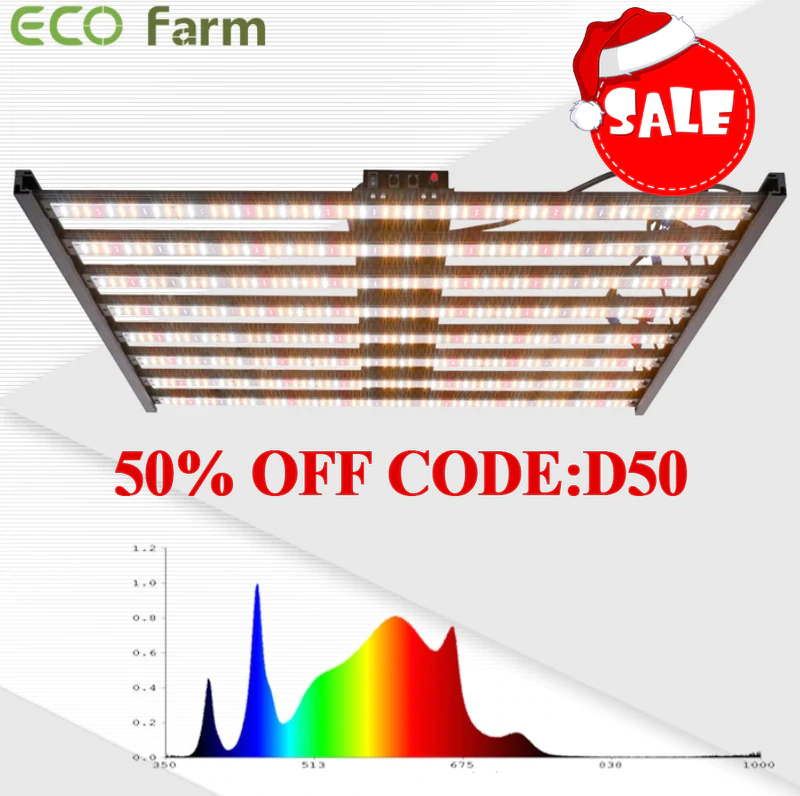
Features:
This ECO Farm LED grow light adopts the top quality equivalent diodes, producing a 800W PPF output of 2019.6 μmol/s and a PAR efficacy of 2.8umol/J, ideal for home and vertical farm planting. This full spectrum grow light meets the lighting requirements of every stage during the plant’s growth cycle. It consists of 660nm of red light, IR, 3000K and 6500K of the white light spectrum, providing plants in all stages from veg to flower with everything they need in the natural sunlight.LED plant lights enable cultivators to produce density buds, the 8-bar configuration allows widely application in the home grow (grow box and grow tents), climate rooms, commercial growing (horizontal and vertical), greenhouse cultivation, vertical racks, hydroponics.
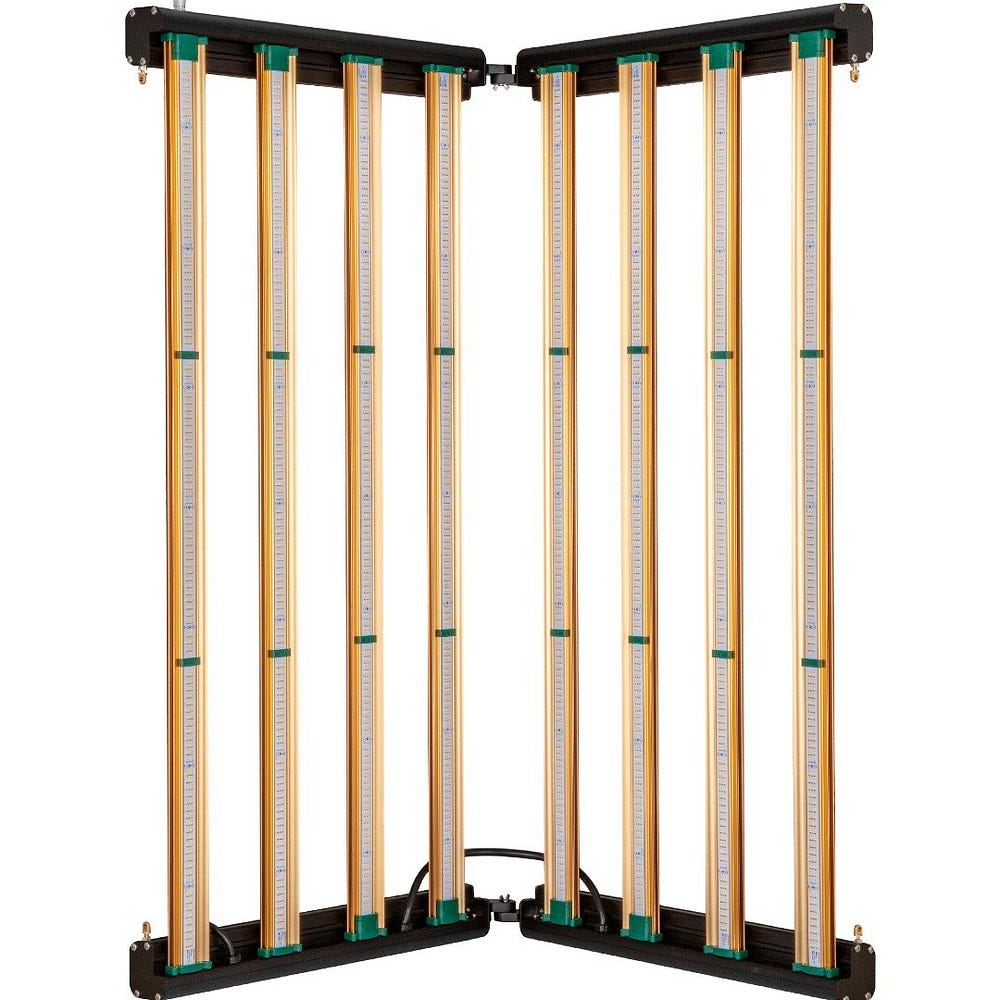
Features:
The Grower’s Choice grow light delivers the entire spectrum of light to your plants, giving them exactly what they need to grow big and beautiful. It has a standard PPF of 1870–1924 umol/m2/s for professional cultivators who demand ultimate light output. The ROI-E720 was engineered with greater dimensions to provide more versatility and better canopy coverage, especially to the outer edges of 4’x4’ cultivation areas. The ROI-E720 is IP65 water-resistant rated, UL8800 certified, and Horti DLC certified for energy efficiency rebate eligibility. With unbeatable safety, reliability, savings, and performance, the ROI-E720 is unquestionably the right choice for cultivators who demand only the best.
What to Look For
After reading this primer on indoor lighting, you can choose the most suitable options for your seed starting needs.
Colour of light
To grow light seedlings, colour temperature is important. Colour temperature describes the colour of light, with excellent light defined by its blue end and warm glow by its red back. All rainbow colours are present in the sun, including the complete spectrum of light.
Although plants use the entire spectrum, red and blue light seems most important for photosynthesis. Plants respond positively to red light though too much red light can make a plant tall and spindly. Foliage plants and short, stocky seedlings benefit from blue light, which regulates their growth. Too much sunlight causes stunting. It is possible to determine what colour a grow light produces using its Kelvin rating.
Hanging the Lights
Ideally, the grow lights should be suspended from the ceiling from where they will be able to shine down on the plants below. It will be necessary for you to mount or hang them, depending on how you want them to look. It is very convenient to use a wire rack for this very reason. My lights can easily be hung from the shelf above using a simple s-hook and a metal chain, and as my plants grow, I can move them up and down according to their needs.
A light mounted in a fixed position, say on the underside of a wooden shelf, can’t be raised or lowered as it is mounted in a fixed position.
To get the best possible results, you need to ensure that the lights you purchase will fit your system — either hanging or mounted.
Bulb technology
A small shop light can cover one or two trays.
Gardeners more commonly use LED bulbs than fluorescent lights. Growing plants using other types of lights, such as sodium vapour lights, is possible, but they are often found in commercial greenhouses.
The fluorescent shop light has long been the standard choice for gardeners, but LEDs have quickly replaced it. The price of LEDs is usually higher than that of fluorescent bulbs, but the energy efficiency and long life make them more attractive. Many sizes and shapes are available and do not produce excess heat. Hardware stores, gardening centres, and online retailers typically carry both types.
Light Intensity
Plants receive light based on their distance from the light source and the wattage of the bulb. For example, a brighter bulb farther away from the plant may provide the same light as a dimmer bulb.
For seedlings grown for the garden, light seedlings with higher intensity light are needed, but different plants require different light intensities. Leaf distance from light should be between 2 and 4 inches in general.
Light Timer
Your new plants will get the right amount of light every day if your new LED light comes with a timing feature.
It is possible to buy an outlet timer if your light does not have one. The timer will turn the light on and off according to a schedule when you set it.
Duration of Light Exposure
In terms of buying a light for growing seedlings, there is still debate about how much supplemental light is best.
A vegetable or garden plant needs at least 16 to 18 hours of light daily; without enough light, it becomes pale and leggy. According to conventional wisdom, lights should be left on for 16 hours daily. According to some growers, it is also recommended that seedlings be grown in 24-hour consistent light daily.
It is easier to keep my grow lights on for my personal preference, so I leave them on constantly. Use a timer to keep the lights on for 16 hours and 8 hours, so you don’t forget to turn them off.
Conclusion
Grow lights are the perfect way to add extra decor and vibrancy to your garden. They can also be used to grow plants indoors to provide you with the necessary light and warmth.
Top 3 Best 600W LED Grow Lights For Indoor Garden Of 2022
September 26, 2022
When trying to grow vegetables indoors or from seed, natural light isn’t always enough, especially in cooler climates or seasons. While some houseplants can survive low-light conditions, others require supplemental light from grow lights.
Light-emitting diode (LED) grow lights are the first choice for many home gardeners because they are an energy-efficient and environmentally friendly option and can produce full-spectrum light. LED grow lights are different from standard LED light bulbs, such as those used in household light fixtures. Read on to learn more about how to choose the best LED grow lights for your home.
How many watts per plant do I need?
When comparing the power of various grow lights, look at the “actual power draw” or “actual power consumption” in watts. Generally speaking, grow lights should use 32 watts per square foot of grow space at the absolute minimum, though 50 to 80 watts per square foot is ideal.
The actual brightness of LED lights is measured in lumens rather than watts, which is another way of measuring light intensity. Vegetables typically require 2,200 lumens per square foot, while other plants generally need approximately 1,375 lumens per square foot.
ECO Farm ECOD Samsung UV+ IR 640W Dimmable LED Grow Light
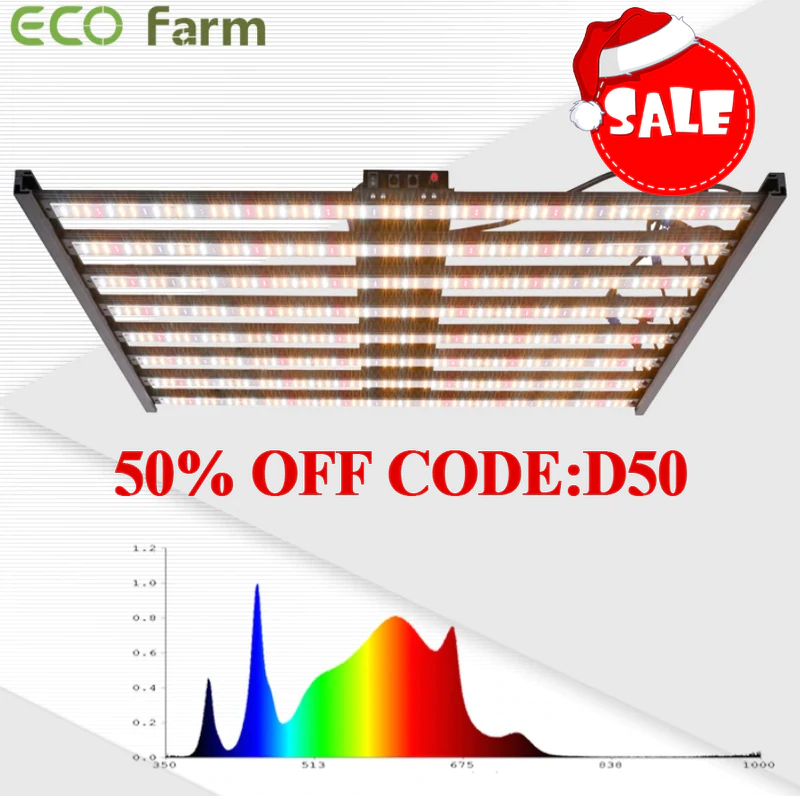
Features:
The ECO Farm LED grow light provides more higher PAR/LUMEN output, it can reduce the amount of electricity needed to grow plants and minimize the heat output, which can keep the grow room in the desired temperature range of 72–88 ℉.The grow light has a power draw of 640W (consumes 0.64 Kw per hour).The average price in the USA is $0.13/kWh,The per hour cost to operate this grow light is $0.08,which can save a lot of money. This LED grow light has high-energy efficiency with 2.8 umol/J,The 1514 μmol/(m2·s) can provides high-intensity full spectrum light for your plants,The 6 bar configuration helps to provide more even coverage accross your tent.
OCL SKWID 1900 Pro LED 680W Grow Light
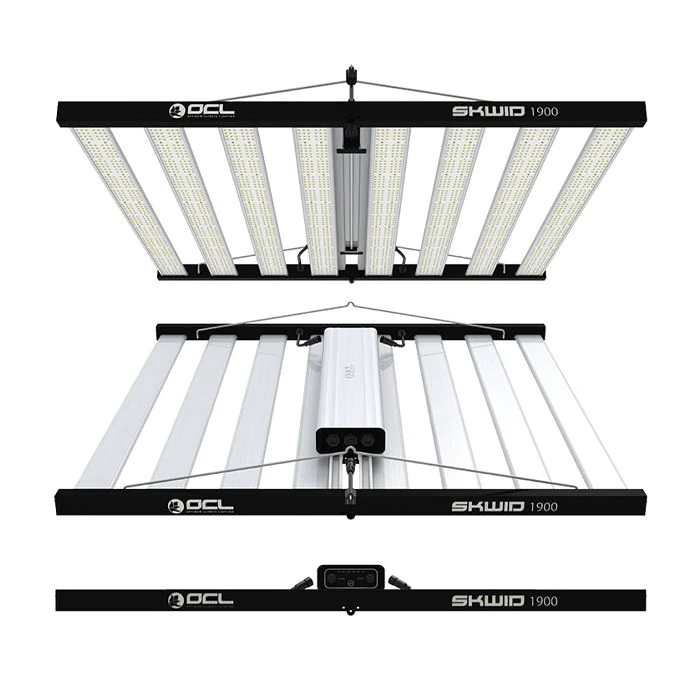
Features:
The OCL SKWID 1900 PRO LED grow light offers an absolute market leading PPF up to 1.938 μmol/s! A high-performance energy-efficient alternative to the traditional commercial 1000W DE HID fixtures. The eight bars are passively cooled in an extra wide shape to enhance spread and coverage. The absence of moving cooling parts reduces the possibility of mechanical failure. The OCL SKWID 1900 PRO LED is dimmable and delivers broad, full-spectrum light anywhere from 400w to 680w while maintaining efficiency. The dim switch on the driver makes it easy to control the light intensity. Developed for growers by growers whose cultivation is in low rooms, on vertical racks, over rolling benches, and in tents. For maximum uniformity, hang the fixture 6–12 inches from the crop.
Photonican Aurora 2000 680W LED Grow Light
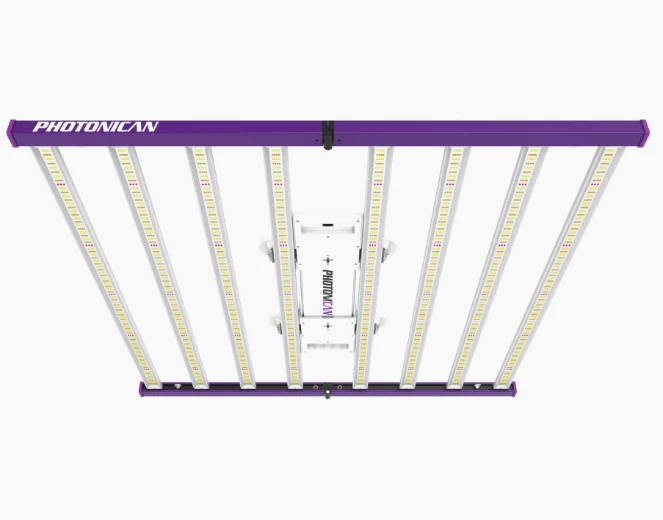
Features:
The Aurora 2000 is a full-spectrum output luminaire that provides consistent energy savings while also delivering an ultra-high red output. The Aurora 2000 is a full spectrum output luminaire that delivers consistent, energy-efficient results. At the same time, it provides ultra-high red output in spectral performance. A 30% increase in red results in better crop quality, higher yields and an increased cycle of the year. Equipped with 8 passively cooled 6063 aerospace-grade aluminium LED strips, the Aurora 2000 provides high-intensity light distribution and uniformity, remarkable PPFD readings compared to other similar luminaires. High PPFD is used in combination with CO2 to maximize plant potential.
What to look for in a good grow light for houseplants
If you’ve done your research when you’re thinking about buying grow lights for your houseplants, you’ll likely find a variety of options, both types and brands. So how do you choose which one to buy? Well, as long as you keep in mind the basic features that your grow light should have to keep your indoor plants healthy, you’re safe. So, without further ado, let’s talk about the key features to keep in mind when choosing.
1. Choose the right light for your plant
There are two types of grow lights that are good for indoor plants — LEDs and fluorescent lights.
The choice will depend on your preferences and needs. While they will both help your houseplants grow healthy and lush at every stage of growth, LED lights are more energy efficient. Although modern fluorescent grow lights save more energy than in the past, LEDs will still use less electricity because it only produces the blue and red light that plants need.
That’s why fluorescent lights are white, and you can use them indoors with no problem, as they won’t look unpleasant if your plants are near the everyday room of your home. When it comes to LED lights, they do produce a purple light, so they can be a bit difficult to see, which is why they’re a better choice for enclosed grow tents or rooms just for plants.
2. Chromatography affects plant growth
Depending on the growth stage of houseplants, they need different colors for energy and growth, so you should use grow lights based on that fact.
However, it is best to use grow lights that emit a full color spectrum, as they are versatile and can be used for every stage and many different plants.
3. Material and weight
If you want to make sure you’re buying a quality grow light, you should choose one that’s made of high-quality, sturdy materials, preferably stainless steel.
Why? Because planting tents and areas around plants, in general, can be damp. Since water is constantly approaching the grow lights, they should be waterproof for extended use.
Even though the material should be sturdy, the grow lights you buy shouldn’t be too heavy, especially if you need to hang them. Lightweight grow lights will be easier to adjust and there won’t be any risk of falling on the plants.
4. Dimming levels so you can use grow lights on different houseplants
As you have already noticed, some models offer the possibility to choose between different lighting intensities, which is also very useful.
This feature offers a lot of versatility and allows you to use the same grow light for different kinds of plants and different stages of the same plant. So if possible, invest in models that provide this solution.
5. Timer
If you travel a lot or generally spend a lot of time outdoors, you should choose grow lights that have an integrated timer, or at least those that can be hooked up to a timer you own or want to buy.
The timer will allow you to choose the time interval at which the plants receive light. Typically, you can set them to turn on and off automatically every 3, 6, or 12 hours, and some can be programmed to do this at the same time every day. Very convenient, right?
6. Easy to set up and adjust
It’s always better to choose simple products, right? With that in mind, buy grow lights that are easy to install, use, and even take with you when necessary.
Plus, it’s very convenient to buy grow lights that can optionally be connected with a daisy-chain cable, because then you only need a single power outlet to connect multiple grow lights — clutter-free installation!
When choosing the right grow light from all the options on the market, it’s always best to look for those that can be easily adjusted. This is important because each plant needs a different distance from the light source.
Not just different plants, but the same plant is in different stages of growth. That’s why, if you plan to hang lights above plants, you should be able to adjust them when needed.
Conclusion
After reviewing this guide, you should now know more about shopping for plant grow lights for your indoor plants. We recommend the ECO Farm grow light for its low power consumption, full-spectrum LEDs, and relatively affordable price. Those on a budget may appreciate the Juhefa full-spectrum grow lamp, which offers great performance at a lower price point.
ECO Farm SP-400 Samsung Full Spectrum LED Grow Light VS Grower's Choice ROI E420
September 23, 2022
Plants need three things to grow and thrive: water, soil, of course, there are sunlight! Ideally, water and soil are easy to obtain, but if you plan to plant anything other than indoor plants indoors, it is a considerable challenge to provide sufficient sunshine. Even if your apartment or house has many windows, you may not be able to get enough sunlight to ensure your indoor garden happiness. Especially in winter.
Usually, your ordinary indoor lights are not suitable for indoor plants, which is a place for plant -growing lights. Plant growth lights provide “sunlight” in the form of artificial lighting. ‘With appropriate lighting, you can produce a variety of indoor plants -the lighting you choose depends on the light requirements and areas that need to be covered. Continue to scroll to understand more information about the best LED grow lights that promote fast -growing indoor plants!
What Color of Light is Best for Plant Growth?
The colors blue and red are considered the best for a plant’s growth and development.
Chlorophylls quickly absorb these color combinations to produce food and energy for the plant; hence, directly helping with the photosynthesis process.
Plants enjoy a higher amount of red, up to 5 times as much as blue.
Blue wavelength helps with root development and strong stem growth, while red wavelength helps flowering.
However, blue has a relatively high amount of energy that can easily damage the plant’s growth with the shortest wavelength among the two.
Therefore, it needs to be carefully mixed with red to limit its overexposure. On the other hand, too much blue light may stunt the root proliferation and prevent vertical growth.
Here is an exciting surprise for you!
Plants only use blue and red light colors for growth is a myth!
Plants are grown with 80–90%red light and 10–20% blue light helps achieve fuller plants with lush thick foliage and appropriate stem lengths.
You may find some artificial grow light to be purple, which contains a combination of red and blue lights.
It is known to be beneficial during the vegetative cycle of plant growth.
However, they emit a higher level of lumens, are quite expensive, and only emit a combo of red and blue, which may not be effective for even plant growth.
A plant requires a combination of various light colors throughout its life span.
Keep this in mind, especially if you are trying to grow plants with the assistance of artificial grow lights.
ECO Farm SP-400 Samsung Foldable Dimmable Full Spectrum LED Grow Light
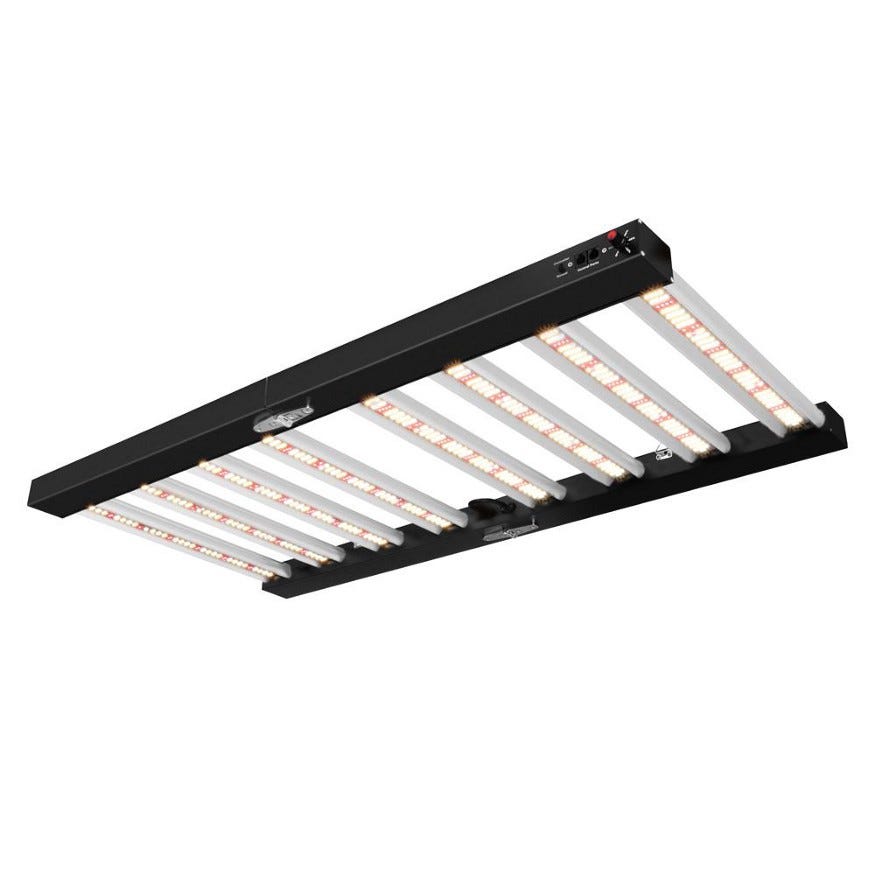
Features:
The ECO Farm LED grow light has lm281b leds(3000k+5000k) +RED 660nm+IR 730nm +UV 395nm ,provides the plant with the full spectrum from seeding to flowering. This light offers great help for all stages of plant growth; It offers more than enough white light, which boosts plants’ blooms, making flowers bigger and more vivid; Blue light promotes plants’ germination, and red light leads to higher yields when combined with blue light.This LED light is more than 50% higher in PPFD compared to HID lamps, as well as having 37% lower power consumption regarding energy saving; This high quality LED light is able to support your plants’ photosynthesis in an optimal, efficient way. The fixture can fold up to 180 degrees, making it compact and easy to install; It won’t take up much space, thus keeping your storage room tidy. With dimming options, this LED grow light can satisfy a range of needs.
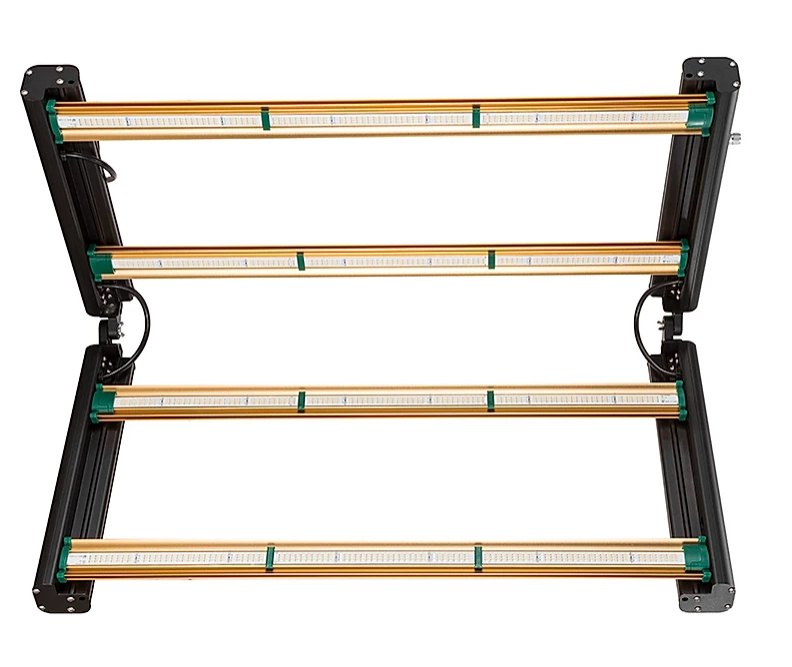
Features:
Utilizing Grower’s Choice proven 3K full PAR spectrum, this LED is perfect for professional cultivators and grow enthusiasts alike, who require a powerful LED fixture with a lower profile frame. This new, sleek LED is also perfect for hobby growers or entry-level professional cultivators who want to maximize their yields while working with limited space. The ROI-e420 is controllable with Grower’s Choice Master Controllers and is compatible with all quality master controllers. Cultivators can set the fixture to turn off and on at desired times, program sunrise/sunset settings, program dimming options and set protective fail-safes to dim or turn off the fixture in the event of excessive room temperatures, such as in the event of an HVAC failure, potential saving gardens from heat damage.
How to choose the LED grow lights?
1.Coverage Area & Light Distance
First of all, you need to know the size of the grow space that your plants will be growing in. Measure your grow space — length, width, and height. Knowing what size grow area you will be growing in is arguably the most important piece of information to know when shopping for LED grow lights . A LED grows light manufacturer will design their grow light for a specific coverage area. The most common coverage areas are 2’x2’, 2’x4’, 3’x3’, 4’x4’, and 5’x5’. As you can see, the length and width are mentioned, but not the height. Hang tight. We will talk about the height of your grow space in a minute. Once you measure your grow space and know what area you need your LED grow light to cover, you can narrow down your search results by filtering to show LED grow lights specific to your grow space.
Now, what about the height of your grow space? That comes into play when we talk about light distance. Every grows light listing should state the coverage area as well as the recommended light distance. The light distance is the distance between the grow light and the top of your plants. Light distance is another thing you need to consider when buying a LED grow light. I’ve had several growers contact me asking for advice on plants that grew too close to their grow light — because they did not factor in the light distance when buying their LED grow light. Let’s go over a quick example. Say your grow space is 4’x4’x6’ (L x W x H) and the recommended light distance on your LED grow light is 24”. So, 6’ (height of grow space) minus 2’ (light distance) equals 4’ tall plants? Right? Wrong! You should also consider the grow pot (which often takes up about 12” depending on the grow pot size) and the “lost distance” above the grow lights which is taken up by the grow light hanging kit.
2.Wattage
This is the most common measure of grow light intensity and is a measure of electricity (watt = amp x volt). This measure can be misleading, though. Some manufacturers (the better ones) give the actual wattage the unit uses — the wall plug wattage. Others, typically lesser brands, will give you the max wattage rating of the LED diodes. To use a simple example, a grow light could call itself 90 watts if it has thirty 3 watt LED’s, however, it is common practice to run LED’s at half wattage to reduce heat production (and therefore heatsink cost) and increase efficiency. So, what was called a 90w grow light could really be 45w (or less!).
Bottom line, you want an actual power draw, not an LED wattage rating. It can be good to be suspicious of overly round numbers — you are likely getting the diode rating and not the actual power draw. Knowing the wattage of the diodes isn’t useless, though. You will get a heck of a lot more light out of a 3-watt diode run at 1 watt than a 1-watt diode run at 1 watt.
3.PPF
PPF (Photosynthetic Photon Flux) measures the total amount of light produced by a grow light in terms of micromoles of photons produced per second (often written as umol/s or μmol/s). This is an important number because unlike PPFD (which will be explained below) it can’t be manipulated and tells you the full amount of light coming from the LED grow lights .
4.PPFD
PPFD (Photosynthetic Photon Flux Density) measures the number of micromoles of photons striking a square meter per second (often written as umol/m2/s, μmol/m2/s, or μmolm-2s-1).
Full daylight sun at noon in the summer is around 2000 μmol/m2/s. What your plants actually need, however, is likely to be much less than that. In fact, because the Sun’s intensity is only that bright for a small portion of the day and because the angle of that intensity changes throughout the day, providing that much light for an extended period of time would very likely be damaging to your plant. A ‘light response curve’ shows how effectively a plant utilizes light at differing intensities. Depending on the plant, at levels greater than 800–1000 μmol/m2/s the efficiency that a plant uses the light starts to slow. Meaning, you can provide your plant more light than this, but you might not see a huge change in outcome.
It’s worth noting that some LED companies can increase their PPFD numbers by measuring extremely close to the grow light or using spot-light like reflectors or lenses. An LED company should always report what distance their PPFD numbers were taken at (e.g., 24 in, etc.).
5.PAR
This is not a measurement at all, but instead, a type of light that can be absorbed by plants (and coincidentally seen by humans). It ranges from 400 to 700nm.
Conclusion
With all the grow light options on the market today, it can be hard to pick the best and stay within your budget. Fortunately, we’ve looked at some options that may benefit your choice and budget without going overboard. There are many other options besides what we have listed. But you now have an idea of the features to check before buying. When it comes to choosing the cheapest grow lights online, it all goes well.
Top 3 Best 1000 Watt LED Grow Light-2022 [Detailed Reviews & Guide)
September 20, 2022
Large area LED grow lights can be expensive. Many grow lights on the market today are either inefficient, do not adequately cover the desired coverage area, or are overpriced. When you invest close to $1,000 (or more) in an LED grow light, you want to be sure that you’re not only getting a high-quality product that will last for years but that you’re also getting an efficient and evenly covered LED grow light that has light to grow in the space. In this article, I’ll disclose my picks for the best 1000W LED grow lights.
ECO Farm ECO Z Lite 1000W LED Grow Light
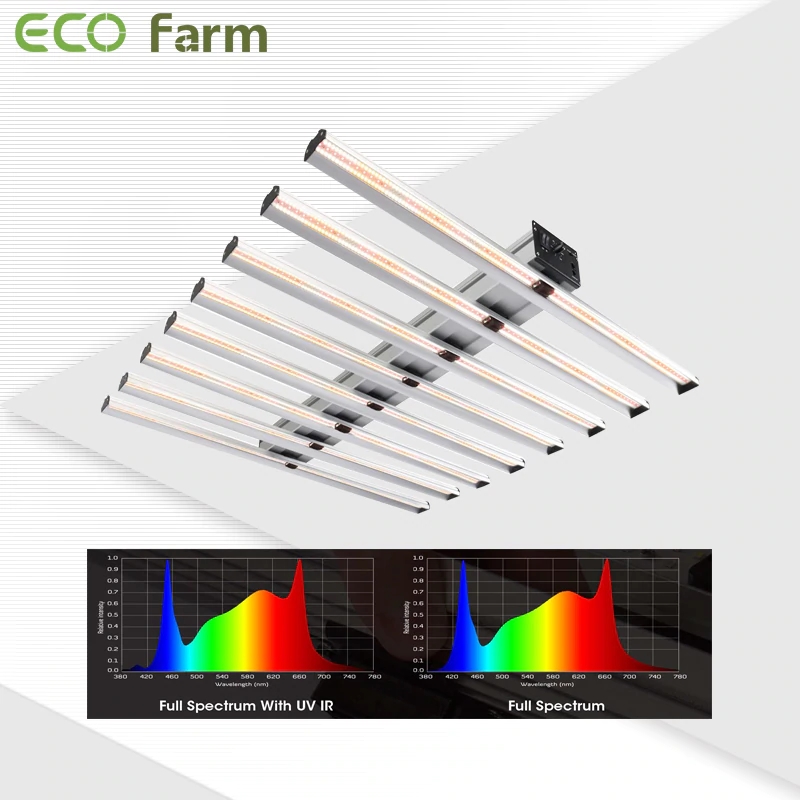
Features:
These ECO Farm LED grow lights ensure concentrated and even lighting and reduce light waste. This plant light brings a 30% increase in output, consumes a total of 1000W, 2800 LEDs, and replaces the traditional 2000W plant light. Achieve higher yields while saving energy costs! Grow lights are easy to assemble yourself in minutes. You can install as many LED strips as you want. Plug and play, effectively save your installation cost and time. The aluminum backplate enables excellent heat dissipation. Pure aluminum light bars better dissipate heat and stay cool, essential for heat dissipation while ensuring long lamp life. No fan, no noise. The cost-effective grow light is designed for home/commercial growers, long-term use of the fan will make noise, but the LED light panel uses aluminum to cool it instead of using a fan, giving you a fanless and quiet growing experience.
Spider Farmer SE1000W Dimmable Full Spectrum CO2 LED Grow Light
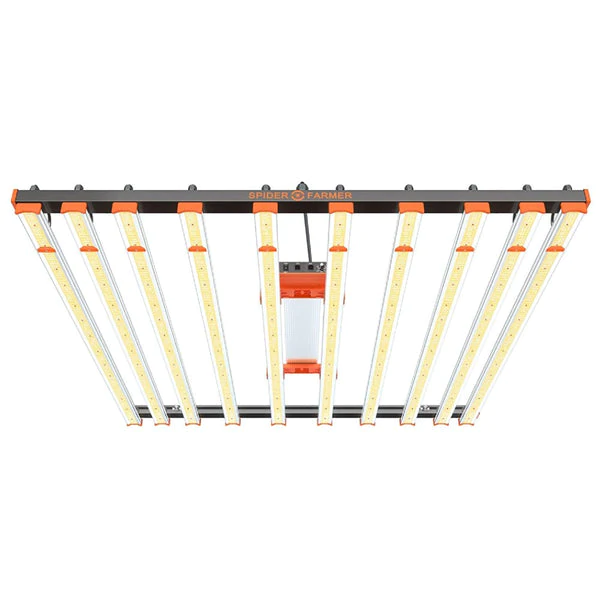
Features:
Spider Farmer LED Grow Lights feature a uniquely designed extension of 10 to provide more even and complete canopy coverage, especially in exterior growing areas. With 3710 SAMSUNG LM301B diodes, the SE1000W Led Grow Light consumes 1000 watts at 2955 umol/s, achieving an impressive PPE of 2.9 umol/J, covering a high yield full cycle growth of 4'x4'. The dimmer knob is ideal for growers to adjust light intensity for different growth stages. The SE1000W grow light comes with a detachable driver and long power cord to reduce ambient heat in the grow space and extend its lifespan. The LED diodes are coated with water repellent, so there is no need to worry about wet environment.
Spectrum King Phoenix 1050W LED Grow Light
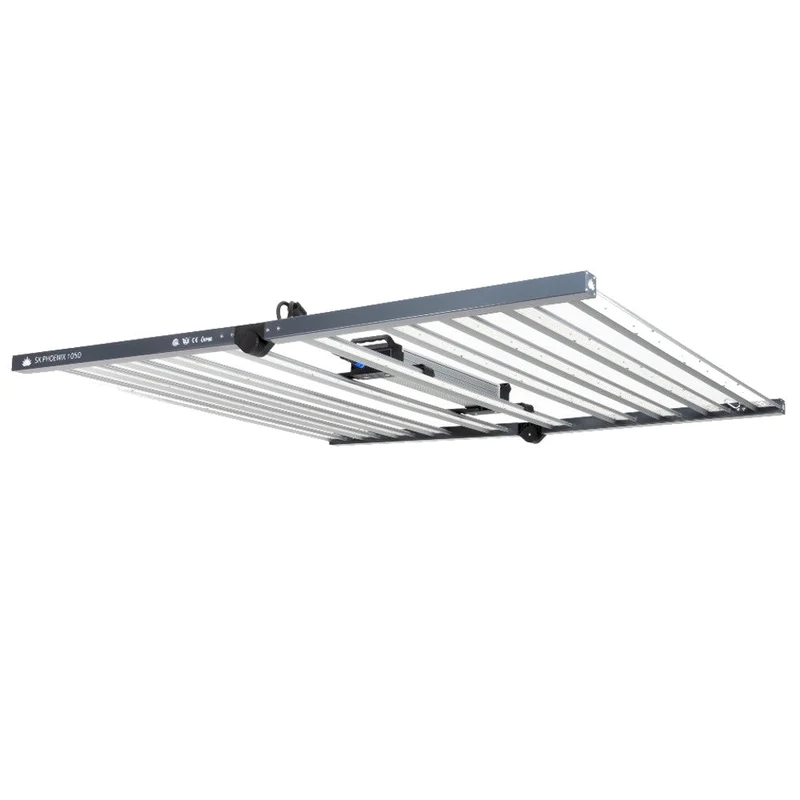
Features:
Spectrum King’s Phoenix 1050W LED Grow Light is a grow lighting beast that unleashes 1050 watts of sun-like light in areas up to 6' x 6', unleashing the ultimate output for your grows. Designed to hang high, the Phoenix 1050 recreates the sunniest summer days for plants that never seem to get enough light. SK Cryo-Therm cooling technology enables an ultra-thin profile that allows maximum airflow and minimizes microclimates. Optimized for single or multi-tier planting near the canopy. For growers who need the biggest, brightest LEDs, the Phoenix 1050W is for you.
What Factors Should You Consider Before Choosing a LED Grow Light?
It would help to consider these factors before choosing a LED Grow light. They include:
i) Light Spectrum
Generally, plants absorb and use light in the red and blue spectrums when undergoing different growth phases. The red, blue, and blue light spectrums are the most important for the photosynthetic activity of plants. Therefore, a full spectrum of Grow light is important to your plant’s growth. You can also use white LED light because it is closer to natural light.
ii) Actual Wattage
You can make the mistake that more wattage is better, but this is not the case. Spectrum plays a big role in the yields and health of your plants. It is important to consider wattage by looking at the cost and preventing plant damage such as bleaching and leaf burn.
You can use the rule of thumb wherein 30W to 40W per square foot plant coverage for light-loving and flowering plants. For low-light plants, you can use 10W-20W per square foot.
iii) Lifespan and Longevity
You need to ensure that the LED grow light you choose is made by a manufacturer that uses heavy-duty materials. Solid, durable materials are the best for Grow lights. They promote a long life span and longevity. You also need to check the wiring to ensure it is done correctly. Improper wiring leads to unnecessary heat and fire hazards.
Therefore the LED grow lights have an average lifespan of 50000 hours if you use them for 10 hours daily.
iv) Canopy Penetration
Every plant canopy is different; light penetrates better on an open and airy than a full dense canopy. However, with a good grow light, no matter how dense the canopy is, the light’s active photons will reach the leaves’ lowest part. Therefore when selecting a LED Grow light, you need to ensure it has a strong light intensity and spectral makeup. This will ensure no matter how dense the canopies are; light still reaches the lowest part of the plant leaves.
v) Energy Efficiency
The amount of electricity your grow light will use will depend on how long it runs daily. LED grow lights use little electricity than other grow lights that give the same output. They also do not produce much heat; therefore, you can put the grow light closer to your plants. Additionally, LED grow lights have a longer lifespan and save you money.
vi) Cool Operation
The LED grow light is cooler compared to HPS and HID light. However, they need an efficient cooling system to dissipate any heat produced. A good LED grow light should have an effective heat dissipate sink to remove heat produced away from the plants and fixture. This is because the heat produced by the grow light can damage the plant and reduce yield.
Conclusion
You know how chaotic the market can be, and unless you have the right metrics, finding the best Led grow lights will be more challenging than it really is. Here we discuss a more reliable way to guide you to the product you really need.
It will ensure that you are not fooled by typical advertisements and review guides full of lavish reviews. Exact details about the product are what you may need when making a decision. A product cannot be good in all respects. But at least a deep review can tell you what you can get out of it and how well it does what you want.
Mars Hydro SP 6500 VS MedicGrow 550W Commercial LED Grow Light
September 01, 2022
Growing plants in an indoor grow tent requires that you provide all the elements that support plants growth. One of the essential elements is light. Light is vital in boosting biomass and prompting change from the vegetative stage to the flowering stage. Thus, you need to install suitable grow lights in your indoor grow tent. Different strains have different light needs, and plants at certain growth stages have varied light needs. And so, you need to prepare very well to be able to leverage grow lights for the best outcome.
What are the benefits of LED grow lights?
Some of the benefits of LED grow lights include:
– They are more energy efficient than other types of grow lights and can save you money in the long run.
- They produce less heat than other types of grow lights, which can be beneficial in warmer climates.
- They last longer than other types of grow lights, which means you don’t have to replace them as often.
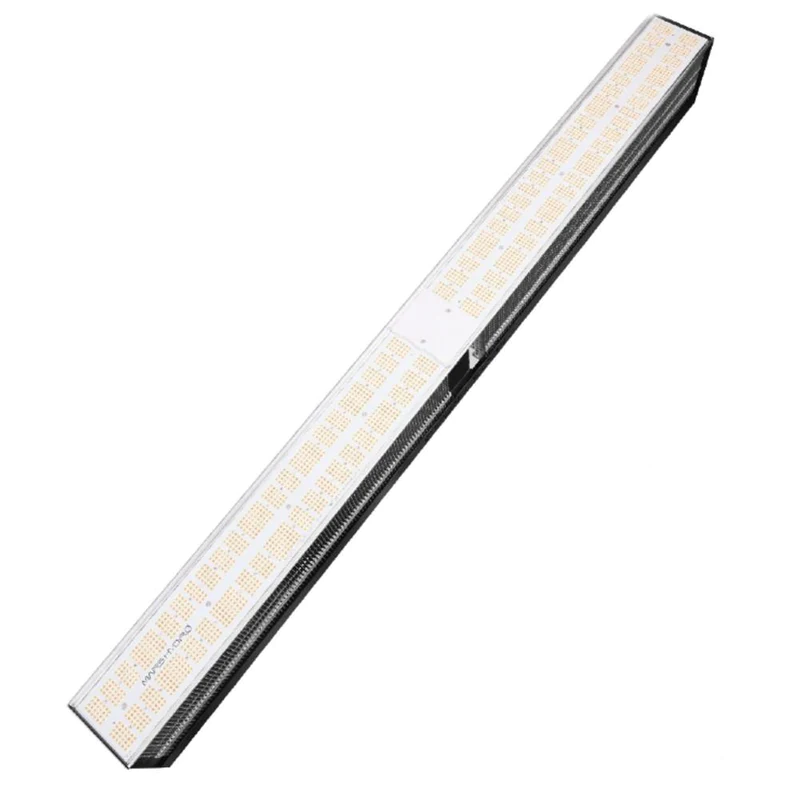
Features:
Using state-of-the-art equipment and technology, Mars Hydro LED Grow Lights provide a huge light output, giving you one of the brightest, highest-yielding full-spectrum lights that work flawlessly in soil growth and hydrological evolution. The SP6500 LED Grow Light can accommodate up to 3' x 5' flower areas and 4' x 5' plant areas. This grow light is equipped with 2356 Samsung LM301B and Osram 660nm LED chips. These chips are of higher quality and more efficient, from vegetables to flowering. This is a true full-spectrum light fixture! 50% increase in yield and quality compared to older blur and/or HPS lamps. The average yield is 2.5 g/W. This model adds a dimming knob, which is more convenient for dimming. Up to 20 lamps can be daisy-chained and controlled by a single lamp.
MedicGrow 550W Commercial LED Grow Light
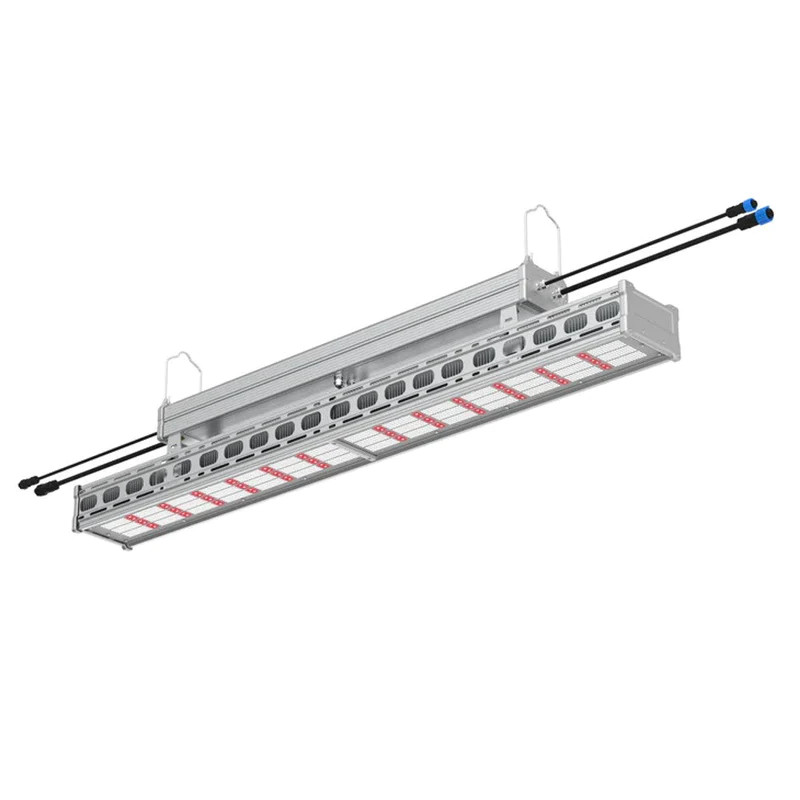
Features:
Medic Grow LED grow lights are specially developed to replace 1000 watt HPS for supplementary or primary lighting in vegetable growing greenhouse applications. This LED grow light is a full cycle LED grow light with a broad spectrum and enhanced red light for maximum yield. Built-in 2300 high-quality white LEDs and OSRAM red LED diodes. This LED grow light provides even light in a coverage area of 6' x 4' space. The average PPFD value was 3271 µmol/m2/s (6 inches above the canopy). The light output PPF was 1540 µmol/s and the PPE was 2.8 µmol/J. It only needs 550 watts of power. It is made into a single LED grow light. With a width of only 5.38 inches, it minimizes the impact of shade on greenhouse crops.
LED Lighting Considerations
Before you buy LED lights for your indoor garden, there are a few considerations you must keep in mind.
Space
How big is your garden? Can the LED lights you are considering cover the entire space? Make sure you accurately measure the size of your garden. Each type of LED light covers a specific range of space. Check the customer reviews to see if the manufacturer’s listed range is accurate.
Brand/Budget
Of course, higher-quality LED lights will come with a steeper price tag. For first-time users, start off with a lower-priced option to get the ball rolling. For experienced users, a higher-quality light is in order. Pay attention to the brand’s reputation and quality of lights. Check on customer reviews to get a good idea of their durability, efficiency, and ease of use.
Spectrum
When buying lights for your garden, you’re going to need certain light spectrums for different stages of growth. A full-spectrum LED light can meet all of your growing news. Full-spectrum lighting provides the red and blue spectrums you need, as well as infrared and UV lighting. Full-spectrum lighting can run cool and save tons of energy over time compared to other lights.
Energy-Efficiency
In general, LED lights provide a higher energy efficiency than fluorescent or HID bulbs. When searching for a grow light, consider its total wattage output. Higher outputs mean more power and energy efficiency.
Light Control
As mentioned above, plants need different light spectrums during different stages of growth. Additionally, they need certain light cycles during each stage.
Seedling: 16 hours of light, 8 hours of darkness
Vegetative: 18 hours of light, 6 hours of darkness
Flowering: 12 hours of light, 12 hours of darkness
Conclusion
Grow lights are often used in hydroponic systems to help plants grow indoors, even in the off-season. There are many lighting options to choose from, but the ideal always depends on your planting area. Before buying any grow lights, consider what you’ll be using them for, where they’ll go into your garden, and how much you want to spend on the lights.
The Best LED Grow Lights of 2022 to Help Your Plants Grow
August 31, 2022
Many greenhouses can benefit from supplemental lighting, especially during certain times of the year. Grow lights in a greenhouse can help if you want to grow vegetables in Minnesota in winter, sprout delicate seedlings in spring, or control sensitive blooms in orchids.
If you have an indoor greenhouse, grow tent or grow room, you need good lighting. But trying to figure out what works best for you can be confusing. Read on as we recommend some good LED grow lights!
What are the most affordable grow lights?
LED grow lights have proven to be the cheapest and most efficient indoor grow lights. At first, LEDs seemed expensive compared to fluorescent lamps. However, in the long run, you will need to replace the fluorescent lamps many times compared to the LEDs that don’t need to be replaced.
Another disadvantage of other grow bulbs is that they need to be replaced before going out. Average growth bulb intensity, except for LEDs that last for six months, especially for plants on stands.
However, LEDs never need to be replaced and can last for years. LED grow light stands are also easy to make; therefore, they are an asset.
ECO Farm ECO8000 800W LED Grow Light
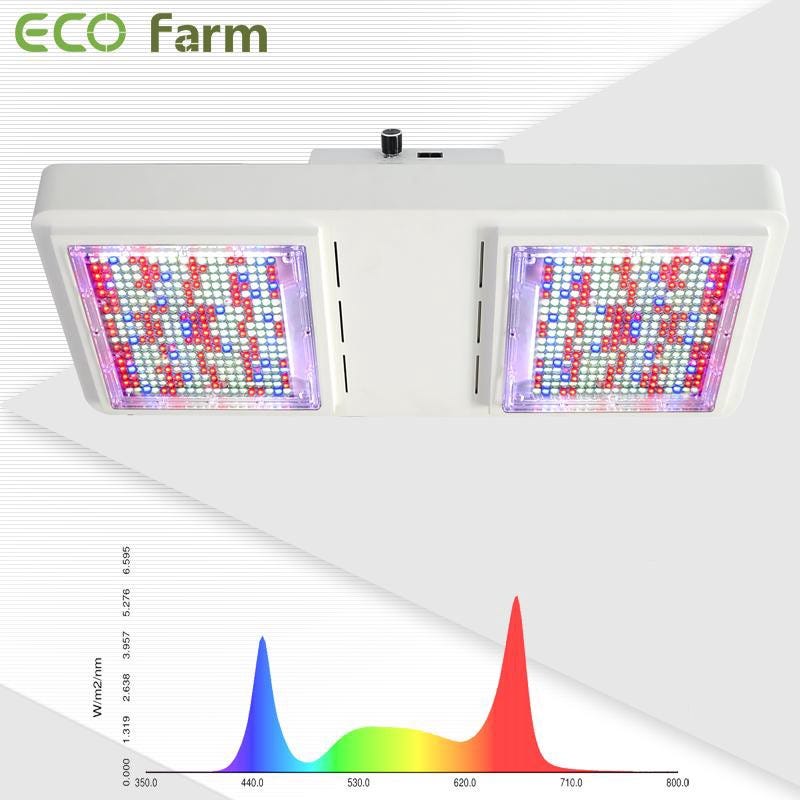
Features:
This ECO Farm grow light has adopted the Sanan LEDs to provide high PAR output, high energy efficiency with 2.5 umol/J while improving light penetration. This grow light is perfect for 5'x5' vegetation cover and 4'x4' flowering cover. Different from traditional HPS, LED grow light uses high-tech SMD LED and reflector technology, and consumes 800W compared to traditional 1000W HPS/MH! It provides brighter light, saves more power, and can save you a lot of money too. Multiple high-speed silent fans and an upgraded aluminum heat sink keep the bulbs operating 50°F to 60°F cooler than other bulbs. At a lower temperature, your plants will not be burnt, which can increase your light time, promote plant growth, and super long use time, so that you don’t have to change lights frequently.
Gavita CT 1930e LED Grow Light
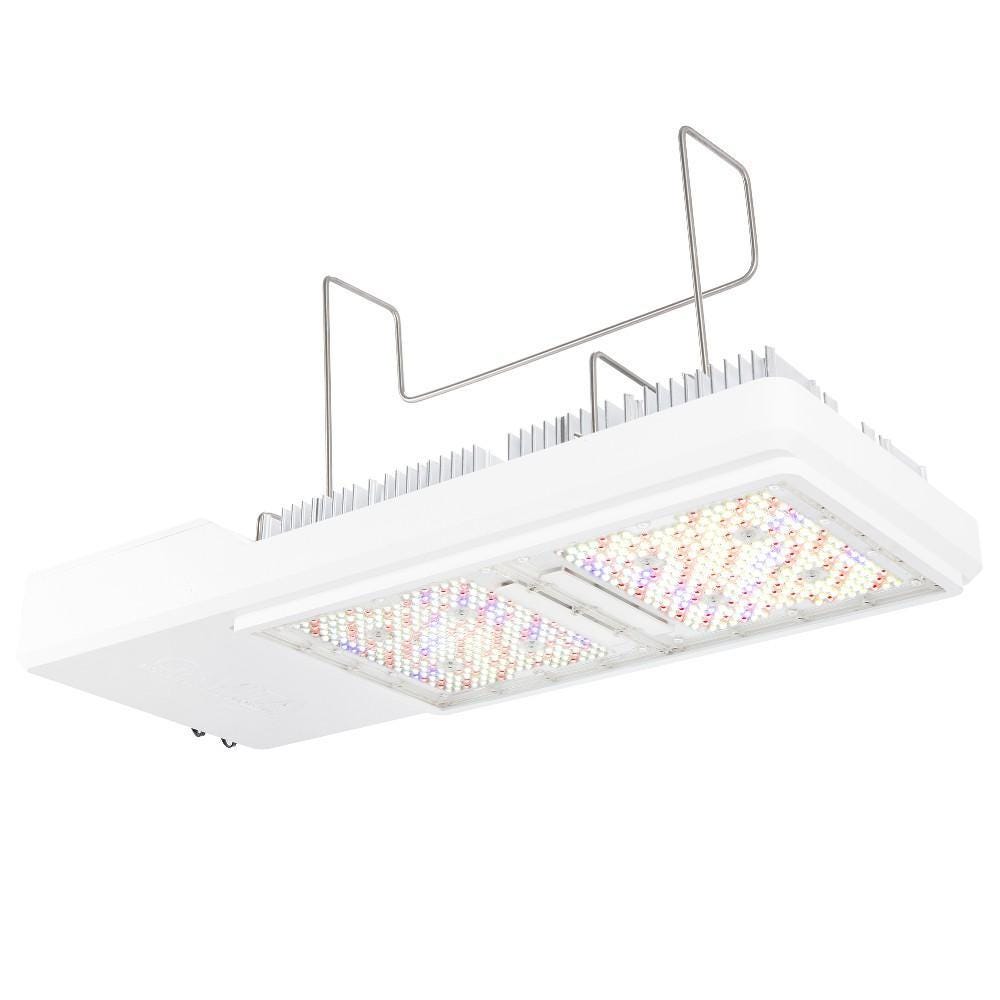
Features:
The Gavita grow light is the first and only LED that is a direct replacement for HPS. With a footprint designed to fit seamlessly in existing HPS layouts, the CT 1930e is a highly energy efficient LED delivering serious growing power. It’s designed to be a 1:1 layout replacement for the fixture that helped revolutionize the industry nearly three decades ago, the Gavita Pro 1000e DE HPS. Compatibility with wiring and electrical requirements for most indoor growing environments means this compact toplight is able to dramatically limit the cost and downtime required to convert facilities of every size.
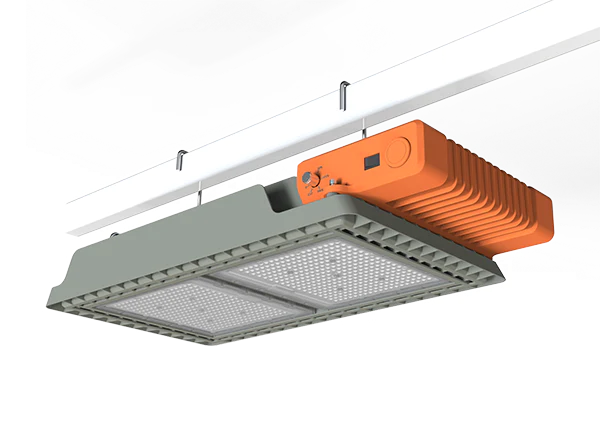
Features:
Grow Pros LED grow lights offer higher efficiency with the same optical performance or higher than standard HPS grow lights. It’s durable, easy to maintain, and better suited for the long-term exponential growth of your plant and business. The Grow Pros AK800 LED operates at 800 watts and has an output power of 2150 μmol, achieving a high efficiency of 2.7 μmol/J. The full-spectrum light output of grow light is beneficial to the complete development of plants, providing more available light for plants from the germination stage and the vegetative and flowering cycle.
The Important of Light for Plants
It is well known that light is essential for the growth of plants. But why exactly do plants need light?
This is one of the most important things to learn about when getting started with grow light bulbs. Understanding why plants need light and how they transform it into energy can help you make the most out of your setup.
Photosynthesis
There’s that word again. But it’s really important.
As mentioned before, photosynthesis is a process used by plant life. Without anything sounding like a biology lecture, photosynthesis is the backbone of how plants work — it is how they create their energy. Water, carbon dioxide and most importantly light are required for photosynthesis.
First off, carbon dioxide is absorbed by the plant’s leaves. Sunlight will then break up the compound. Water and air mix with this, in turn creating glucose. The glucose molecules will then start to stick together and make carbohydrates — which is what the plant will use for energy.
How Much Light Do Plants Need?
Obviously, this is going to vary depending on the plant. But before you start using grow light light bulbs to grow your plants indoors, start by trying to figure out how much light your plants are actually going to need.
If you are going to be growing some indoor plants that will not be receiving natural sunlight, then around sixteen to eighteen hours of light are going to be necessary. If you happen to have plants that will receive some light then look for around 12 to 14 hours. Try to use light for around the same amount of time that plants will receive it during the day.
If you are a perfectionist and are unsure how much light to give to a plant, the best thing to do is to research it. However, it is not unusual for beginners to just simply try to replicate the amount of light their plant would receive in the natural world.
Grow Lights Compared to The Sun
It is simply a fact that sunlight can be better for plants compared to using artificial light. This is because the sun is a lot more powerful than grow light bulbs. Plants, being a natural occurrence on Earth, are also more accustomed to the sun since this is how nature works. The universe’s creator pretty much intended for plants to grow outdoors in nature, rather than with artificial lights.
But don’t let this throw you off. There are so many benefits to using grow lights too. Thanks to the technology we have in the modern world, some lights can be almost as good as sunlight!
Light comes in a whole spectrum of different colors. Plants require different types of light too, red and blue light specifically. The red light will help plants create fruit and flowers, and blue will help the growth of leaves. Sunlight, on the other hand, provides the entire spectrum of light. The majority of typical light bulbs will only produce yellow or green light, while others may be used for red or blue light. A lot of grow lights are now designed to cover the entire spectrum.
Conclusion
Finally, it’s no secret that LED grow lights are gaining popularity among growers. However, as popularity increased, there was an influx of lower-quality products. It is very important to make sure you read the reviews of other users before buying LED grow lights. Only by doing so can you be sure of getting a quality product that meets your needs. Thanks for reading!
3 Best 400W Quantum Board LED Grow lights in 2022
August 27, 2022
Here’s a detailed discussion of some of the best Quantum LED grow lights that can give you the necessary information to buy grow lights for your indoor grow room.
What are the main advantages of buying Quantum Board LEDs?
There are many benefits to growing plants under Quantum Board LEDs. Below, we’ll briefly list each to illustrate why quantum boards are the dominant style of LED grow lights.
Quantum boards are energy efficient
Quantum boards are efficient LED grow lights because they use SMD LED diodes such as those common to Samsung (LM301B/H) and Osram.
Compared to COB LED lamps, quantum panels consume less energy while producing extremely rich PAR lighting. If you’re looking for an energy efficient design while maximizing lumen counts, look no further than the Quantum Board.
Quantum panels consume less energy while producing extremely rich PAR lighting.
Quantum plates spread light evenly
The main reason HLG originally invented quantum panels was to spread light evenly across the tree canopy.
While the COB LEDs pass through the canopy, their light diminishes towards the outer edge. Instead, Quantum Board LEDs focus on consistent maximum coverage, allowing plants growers to get the most out of it.
Quantum boards offer better thermal management
Another benefit of growing plants with quantum board LEDs is that they utilize passive cooling technology to dissipate heat.
Unlike traditional or COB LEDs, quantum boards do not have fans. Instead, heat sinks strategically placed on the surface passively cool the quantum plate system.
Therefore, quantum boards provide excellent thermal management. In the end, your overall HVAC costs will be lower because your quantum boards don’t dissipate as much heat.
Quantum panels could fit into low-hanging roofs
One of the great things about owning a Quantum Board LED grow light is that you don’t need a lot of space to fit it.
In other words, plants growers in tight spaces (i.e. closets or low ceiling areas) will benefit from a paper-thin design using quantum boards.
ECO Farm ECOT 480W Dimmable Samsung LM301H Quantum board LED Grow Light
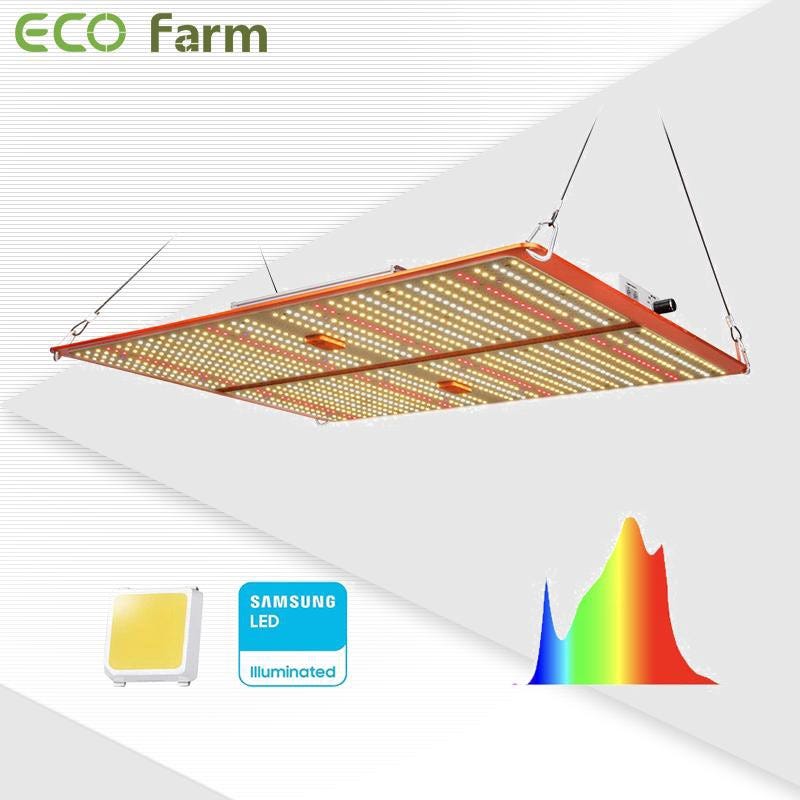
Features:
ECO Farm Grow lights utilize the latest in high yielding LEDs technology today-Samsung LM301H diodes, high Energy Efficiency with 2.8 umol/J, make you get 30% higher yield compare OLD blurple led lights; Max 2.0g yield per wattage (power draw), achieve maximum quality and quantity, much better than traditional HPS grow systems. Only consumes 120w, running 50% less power than the HPS or other SMD LEDs or Blurple lamps.The grow light can be adjusted the light intensity at liberty. Multi-light Connection with unified dimming especially beneficial for large area of indoor growing and commercial planting. It is idea for all growth stages, excellent full spectrum- white, blue, red and IR (3000K, 5000K, 660nm and IR 760nm & 395nm UV). 3000K diodes providing more reddish light and the 5000K providing more blueish. The 660nm red and IR light is especially useful during bloom, where it speeds up flowering time and boost yields.
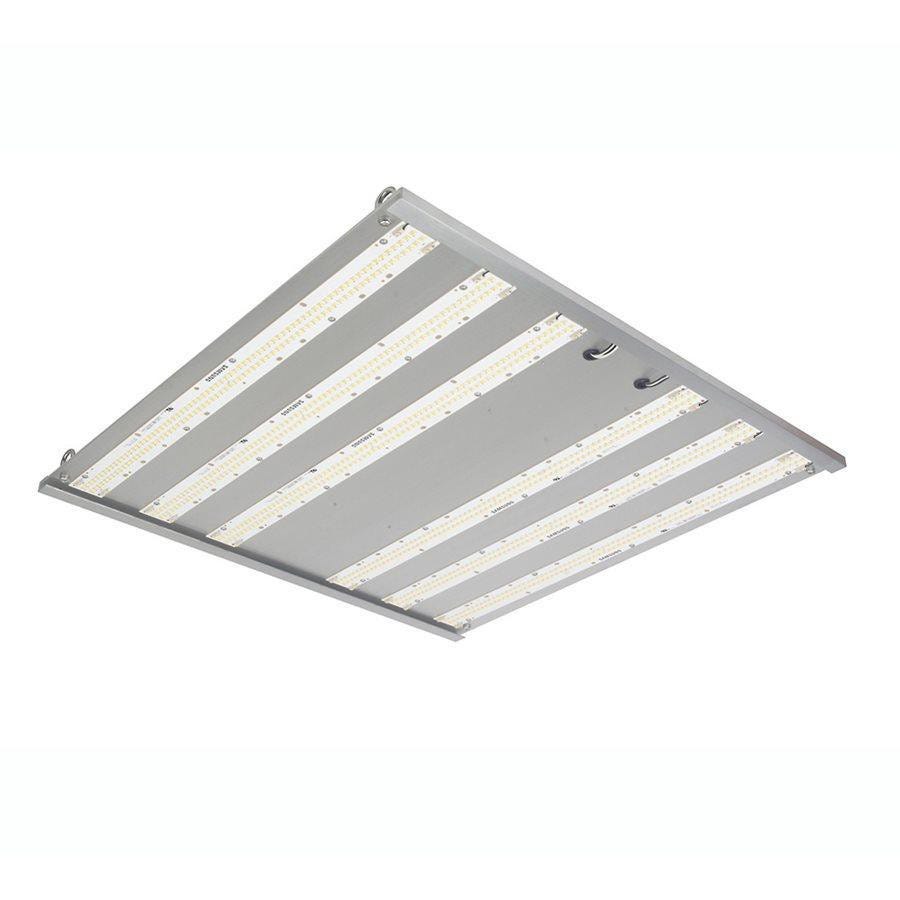
Features:
The Equinox 1000 utilizes the latest LED technology available from Samsung to deliver an impressive light output of 1057μmol/s. Drawing only 480 watts this light offers a 56% energy reduction when replacing a 1000W HPS light. The rugged workhorse design makes this fixture the obvious choice for growers seeking a high production and low energy lighting solution. The rugged high-grade aluminium design ensures this fixture can be utilized in tough working environments with minimal risk of damage.
VIPARSPECTRA XS4000 LED Grow Light
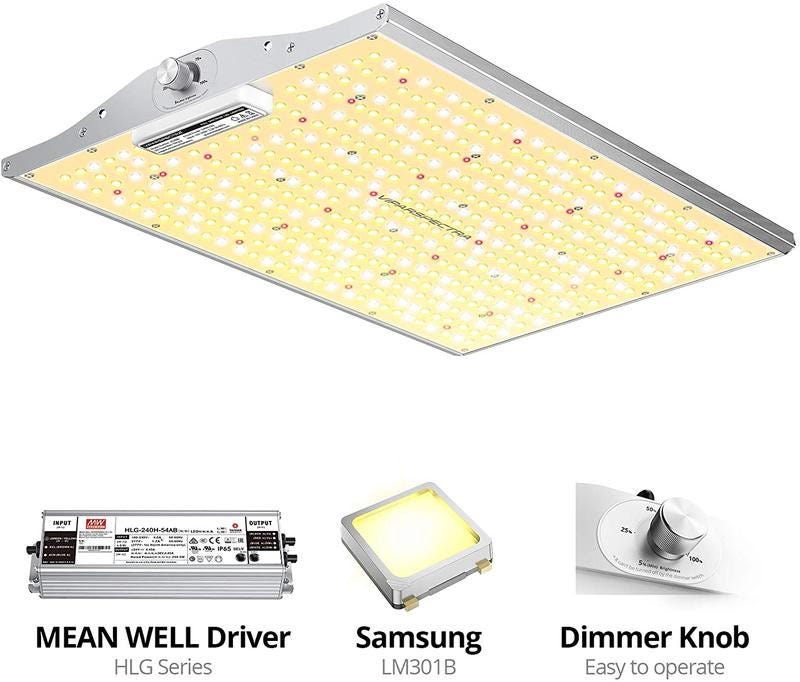
Features:
The ViparSpectra grow light is an affordable 480 watt LED grow light that delivers up to 70% higher output than other traditional LED grow lights on the market. The XS4000 features high-quality Samsung LM301B diodes to provide wallet-saving efficiency while generating more usable light per watt. The XS4000’s 3000k warm white, 5000k white, 660nm deep red, and 730nm IR light give your plants the full spectrum light they desire. The red and IR light are especially useful during the flowering stage, which can speed up bloom time and increase yields so you get the best harvest you can. The added dimmer knob lets the grower adjust the light intensity to accommodate plants in all stages of growth — from veg to flower.
Quantum Board LED Grow Lights Buying Guide
Area of coverage
There are different sizes of light and choosing the right one for your space is important. Some people have a small grow area while others have a large grow area. Select a quantum board LED light that perfectly covers your grow area. You wouldn’t want to install a small grow light in a big space or a big grow light in a large area.
Type of plants
Pick the right quantum board LED grow light for your plants. Different grow lights are suitable for different plants. Make sure that you select a QB LED grow light that can fit your type of plant and at a growth stage that it is. Even though certain lights are best suitable for certain stages, most of the quantum board grow lights are versatile and can be utilized in any stage of the plant’s growth.
Brand
Don’t just pick from any brand on the market as not every brand out there offers quality and durable quantum board led grow lights. Consider buying your QG light from notable and trusted brands such as Horticultural Lighting Group, Spider Farmer, and EOC Farm.
Price
Different quantum board LED lights come with varying features. The more advanced the grow light is the more expensive it will be. Come up with a budget and compare different quantum board LED grow lights that are within your price range.
Don’t just go for the low-end grow lights as they might not be as powerful or durable as the high-end LED grow lights.
Warranty
Consider buying a quantum board LED grow light with a warranty as some units come with defective parts. The best brands such as Horticultural Lighting Group brand offers a warranty on their products.
This covers the product from defects in material and workmanship.
Conclusion
Choosing the best Quantum Board LED grow lights is important if you want to increase your growth yield. A high-efficiency grow light will provide even coverage and deeper penetration for excellent growth.
I hope you found a grow light that not only meets your needs but also your budget. If you’re a small grower, be sure to choose a quality QB LED light that provides the full spectrum and provides plenty of coverage for your plants. For professional growers, choose the best LED grow lights with high power.
Mammoth Lighting Fold Series MF04 LED Grow Light VS Grower's Choice ROI E420
August 26, 2022
If you like to grow plants indoors, you need to make sure they have all the basic requirements they need to grow. In addition to water and nutrients, plants need enough light to grow.
Growing plants indoors? You need to find the best light for your plants. In fact, you have several options, but LED grow lights are the most popular type of lights used for indoor growing.
We’ll detail the benefits of using the best LED grow lights below and what else you need to know before you buy, but first let’s cover why they’re so popular.
Why buy LED grow lights?
While you may need artificial light, you may be wondering which one to buy. There are various types on the market, from fluorescent lamps to HID and HPS variants and more. There are tons of options, so why choose LED grow lights over everything? Well, here are the advantages of all the other different types of lights that LEDs offer, and why we think they are the best.
First, they consume far less power than most other types of lights, making them very energy efficient. However, this also affects their lifespan, making them thousands of hours longer than HID or HPS lamps. They rarely stop working completely, but usually reduce the brightness over time. If you need 24/7 access to your lights, LEDs are the right choice.
In addition to this, they can use a specific spectrum that matches the optimal absorption range of various plants, which means they are more efficient than HPS lamps of comparable brightness. They are also more versatile in terms of placement, as they can be used as ceiling lamps, floor lamps, wall lamps, whatever you need, and they can even be placed in awkward places with non-square units.
Another reason they’re so much better than other types of lighting is that they emit far less heat, which means you don’t need to use them in ventilated areas only, and you don’t have to put any extra effort into cooling your plants.
While the initial cost of LED grow lights is higher, it pays off hugely over time. They’re still a new technology so will drop over time and they’ll get better than HPS lights.
Mammoth Lighting Fold Series MF04 LED Grow Light (Veg)
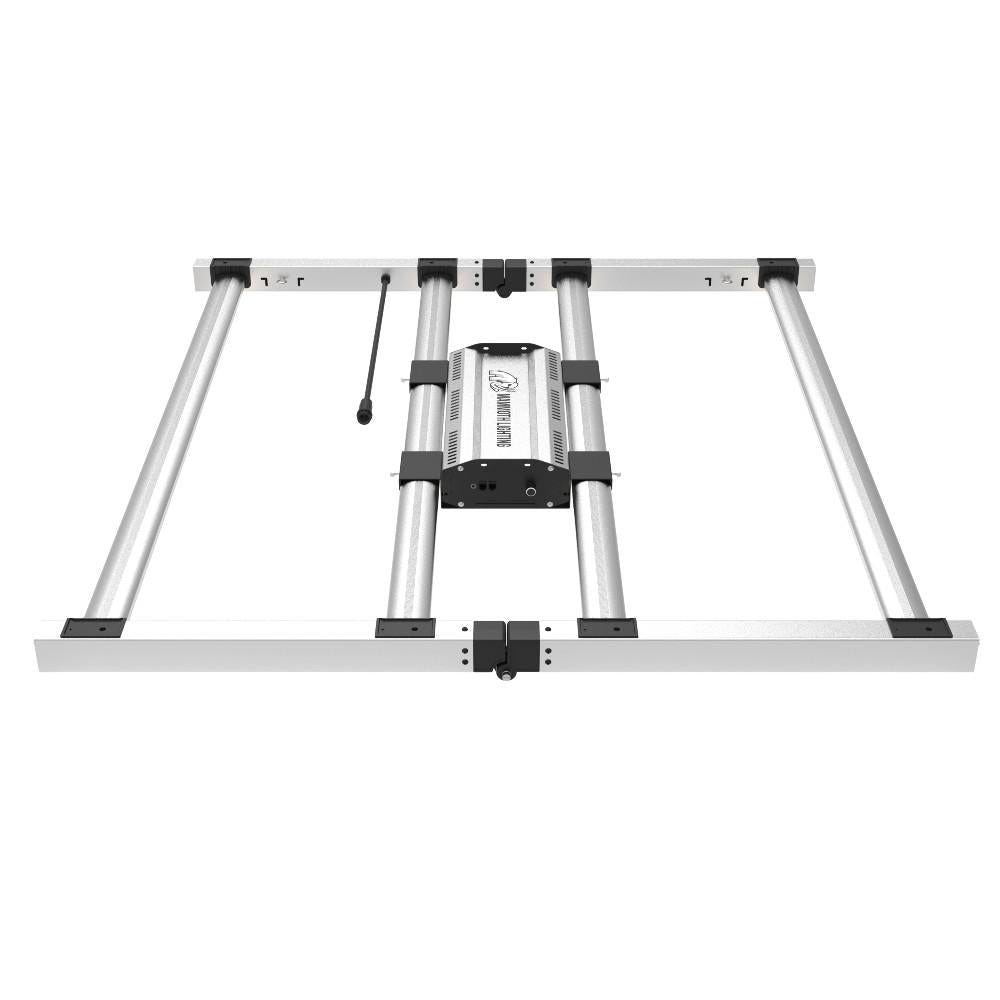
Features:
Mammoth Lighting was developed by indoor growers after years of careful trial and testing. Scientifically engineered to provide the highest level of PAR output and balanced coverage in LED growth markets. Mammoth LED grow lights are made of high-quality Samsung diodes. The light contains a continuous range of wavelengths from blue and green to red, creating a light mix that matches natural sunlight. Mammoth customizes its spectrum to optimize plant growth and increase yields while consuming less energy and reducing operating costs compared to traditional gardening techniques.

Features:
Utilizing Grower’s Choice proven 3K full PAR spectrum, this LED is perfect for professional cultivators and grow enthusiasts alike, who require a powerful LED fixture with a lower profile frame. This new, sleek LED is also perfect for hobby growers or entry-level professional cultivators who want to maximize their yields while working with limited space. The ROI-e420 is controllable with Grower’s Choice Master Controllers and is compatible with all quality master controllers. Cultivators can set the fixture to turn off and on at desired times, program sunrise/sunset settings, program dimming options and set protective fail-safes to dim or turn off the fixture in the event of excessive room temperatures, such as in the event of an HVAC failure, potential saving gardens from heat damage.
What Makes the Best LED Grow Light?
Below are the features you should expect to find in high-quality LED illumination for growing plants.
1. Color Spectrum for Plants
Why do plants grown outdoors do well? That’s because the sunlight contains full-spectrum colors the plants need for growth and development. This means that you should look for a model with such capabilities. Full-spectrum LEDs provide all the important hues and colors for different stages of plant growth. The most important colors are:
Blue light. This enables the plants to thrive during their early stages. They are able to absorb it during their vegetative stage.
Purple light. The purple color is also necessary for the vegetative stage. However, it is not very effective for photosynthesis like blue illumination.
Red light. Plants need this color in their later stages of development. It also helps buds to flower.
White light. You can use the white color alone since it has all the color spectrums required by plants in all their development stages.
2. Light Intensity
The light intensity of LED grow lights is determined by Photosynthetically Active Radiation (PAR). The PAR is usually the type or amount of illumination that LED grow lights produce. In this way you can regulate the photosynthetic features of sunlight that plants need.
The ordinary bulbs produce less PAR. It explains why they are not commonly used in indoor gardens.
Light intensity is the measure of the amount of illumination that can produce photosynthesis. Photosynthesis is a series of chemical reactions that are responsible for producing glucose and oxygen from water and carbon dioxide. The reaction requires illumination energy in order to work.
Understand the Intensity and Its Impact
You can determine intensity in 2 ways:
Wavelength
Photosynthetically Active Radiation (PAR).
The wavelength, measured in nanometers, determines what part of the spectrum a plant uses for photosynthesis. The PAR determines how much energy there is in those wavelengths.
3 Types of PAR
There are three main types of PAR: blue light, red light, and infrared (IR).
Grow illumination with a high PAR rating fits better for growing plants. These ones are the brightest and they are very good for plants since they greatly enhance the development of leaves. They also have the required amount of photons that plants need for flowering and growth.
Lack of enough luminosity may cause the leaves to turn yellowish. You should check the recommended footprint by the manufacturer. This is the easiest way to know the best grow illumination that will be suitable for your plants.
4. Grow Light Power Consumption
The good news is that these types of lights are very cost-effective. You need little power to run them. However, their power consumption differs from one model to the other which means that some consume a lot of electricity. A model that produces bright light without consuming a lot of electricity can be a great choice.
The amount of power the unit consumes is determined in watts. In other words, models with high wattage are likely to consume more power. However, models with low wattage may not provide the required level of brightness. A model with at least 1000W will be a great option.
5. Lighting Footprint
Even if brighter illumination may help your plants to produce better yields, sometimes it may be very dangerous and may cause your plants to dry due to too much heat. Therefore, you need to determine the best amount of illumination that is suitable for your plants.
To do this, measure the size of the area you would want the light to project. This area is known as the footprint. LED lights can only cover a limited area or footprint.
Therefore, you need to ensure that the model you have chosen
matches the area you would like the light to cover.
In short, the illumination footprint provided by the LED luminosity should not be more than the growing space because this might cause the leaves to bleach or curl. It will also be a waste of electricity. You can check this information from the details provided by the manufacturer.
6. Plant Photoperiods
This simply refers to the amount of light you give the plants within 24 hours. When growing plants outdoors, they have a limited photoperiod since they use sunlight. In most cases, the plants will be subjected to sun for 24 hours during the day or less depending on the season.
Growing plants indoors allows you to extend the photoperiods of plants according to your requirement since you can leave the LED grow illumination even for 24-hours.
As a result, plants grown indoors may grow faster than those grown outdoors especially during the winter.
Conclusion
LED lighting has many advantages in indoor gardens compared to other types of lighting. They are very effective because they can produce as many colors as the plants need. If you’ve been thinking about buying the right model for your indoor garden, we hope you’ve learned something from this guide.
